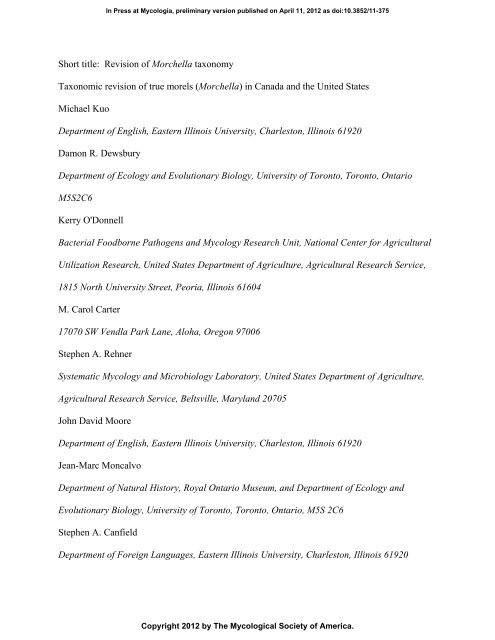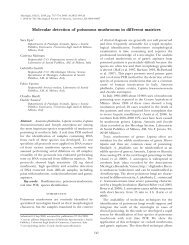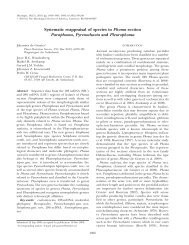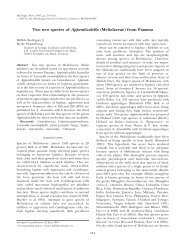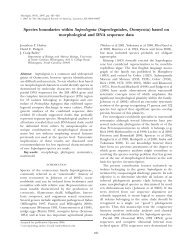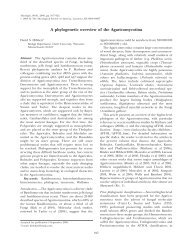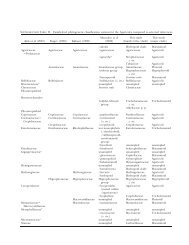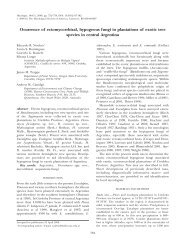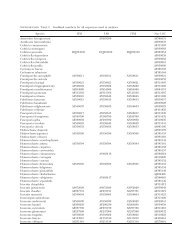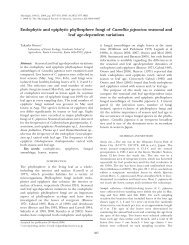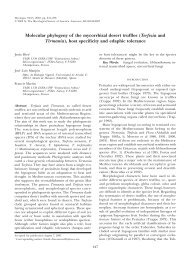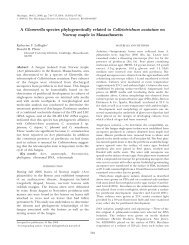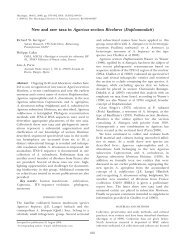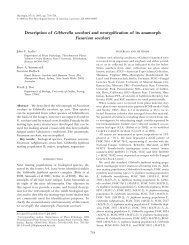Short title: Revision of Morchella taxonomy Taxonomic ... - Mycologia
Short title: Revision of Morchella taxonomy Taxonomic ... - Mycologia
Short title: Revision of Morchella taxonomy Taxonomic ... - Mycologia
You also want an ePaper? Increase the reach of your titles
YUMPU automatically turns print PDFs into web optimized ePapers that Google loves.
<strong>Short</strong> <strong>title</strong>: <strong>Revision</strong> <strong>of</strong> <strong>Morchella</strong> <strong>taxonomy</strong><br />
<strong>Taxonomic</strong> revision <strong>of</strong> true morels (<strong>Morchella</strong>) in Canada and the United States<br />
Michael Kuo<br />
Department <strong>of</strong> English, Eastern Illinois University, Charleston, Illinois 61920<br />
Damon R. Dewsbury<br />
Department <strong>of</strong> Ecology and Evolutionary Biology, University <strong>of</strong> Toronto, Toronto, Ontario<br />
M5S2C6<br />
Kerry O'Donnell<br />
Bacterial Foodborne Pathogens and Mycology Research Unit, National Center for Agricultural<br />
Utilization Research, United States Department <strong>of</strong> Agriculture, Agricultural Research Service,<br />
1815 North University Street, Peoria, Illinois 61604<br />
M. Carol Carter<br />
17070 SW Vendla Park Lane, Aloha, Oregon 97006<br />
Stephen A. Rehner<br />
Systematic Mycology and Microbiology Laboratory, United States Department <strong>of</strong> Agriculture,<br />
Agricultural Research Service, Beltsville, Maryland 20705<br />
John David Moore<br />
Department <strong>of</strong> English, Eastern Illinois University, Charleston, Illinois 61920<br />
Jean-Marc Moncalvo<br />
Department <strong>of</strong> Natural History, Royal Ontario Museum, and Department <strong>of</strong> Ecology and<br />
Evolutionary Biology, University <strong>of</strong> Toronto, Toronto, Ontario, M5S 2C6<br />
Stephen A. Canfield<br />
In Press at <strong>Mycologia</strong>, preliminary version published on April 11, 2012 as doi:10.3852/11-375<br />
Department <strong>of</strong> Foreign Languages, Eastern Illinois University, Charleston, Illinois 61920<br />
Copyright 2012 by The Mycological Society <strong>of</strong> America.
Steven L. Stephenson<br />
Department <strong>of</strong> Biological Sciences, University <strong>of</strong> Arkansas, Fayetteville, Arkansas 72701<br />
Andrew S. Methven<br />
Department <strong>of</strong> Biological Sciences, Eastern Illinois University, Charleston, Illinois 61920<br />
Thomas J. Volk¹<br />
Department <strong>of</strong> Biology, University <strong>of</strong> Wisconsin, La Crosse, Wisconsin 54601<br />
Abstract: Recent molecular phylogenetic studies have revealed the existence <strong>of</strong> at least 50<br />
species <strong>of</strong> <strong>Morchella</strong> worldwide and demonstrated a high degree <strong>of</strong> continental endemism within<br />
the genus. Here we describe 19 phylogenetic species <strong>of</strong> <strong>Morchella</strong> from North America, 14 <strong>of</strong><br />
which are new (M. diminutiva, M. virginiana, M. esculentoides, M. prava, M. cryptica, M.<br />
frustrata, M. populiphila, M. sextelata, M. septimelata, M. capitata, M. importuna, M. snyderi,<br />
M. brunnea and M. septentrionalis). Existing species names (M. rufobrunnea, M. tomentosa, M.<br />
punctipes and M. angusticeps) are applied to four phylogenetic species, and formal description <strong>of</strong><br />
one species (M. sp. "Mel-8") is deferred pending study <strong>of</strong> additional material. Methods for<br />
assessing morphological features in <strong>Morchella</strong> are delineated, and a key to the known<br />
phylogenetic species <strong>of</strong> <strong>Morchella</strong> in North America is provided. Type studies <strong>of</strong> M. crassistipa,<br />
M. hotsonii, M. angusticeps and M. punctipes are provided. <strong>Morchella</strong> crassistipa is designated<br />
nomen dubium.<br />
Key words: Ascospore, identification key, <strong>Morchella</strong>ceae, morels, morphology, North<br />
America, pits, <strong>taxonomy</strong><br />
INTRODUCTION<br />
Morels (species <strong>of</strong> <strong>Morchella</strong> Dill. ex Pers.) are highly valued edible mushrooms in the northern<br />
hemisphere, especially in Europe and North America (Weber 1995, Kuo 2005), but we still lack
an understanding <strong>of</strong> many aspects <strong>of</strong> their biology, <strong>taxonomy</strong> and distribution. Molecular<br />
phylogenetic analyses <strong>of</strong> 590 <strong>Morchella</strong> collections (O'Donnell et al. 2011) revealed at least 41<br />
phylogenetic species worldwide, 19 <strong>of</strong> which appeared to be endemic to North America. Results<br />
additionally indicated a high degree <strong>of</strong> continental endemism for the genus, with only two <strong>of</strong> the<br />
41 species occurring naturally in both Europe and Asia and none occurring naturally in both<br />
North America and Eurasia (although a few North American species appear to have been<br />
introduced into Turkey; see Taşkın et al. 2010, 2012). Because extensive sampling has indicated<br />
strict North American endemism, existing European and Asian species names (including among<br />
others the well known names M. esculenta [L] Pers., M. elata Fr., M. semilibera DC and M.<br />
conica Pers.) could not be applied to North American morels. We studied the type collections <strong>of</strong><br />
the six species originally described from North America (M. tomentosa M. Kuo, M. rufobrunnea<br />
Guzmán & F. Tapia, M. angusticeps Peck, M. punctipes Peck, M. hotsonii Snyder, M. crassistipa<br />
Snyder) to investigate the contemporary applicability <strong>of</strong> these species names (see<br />
SUPPLEMENTARY MATERIALS). We also studied morphological, ecological and distributional data<br />
from 244 North American collections identified phylogenetically to assess whether these species<br />
can be defined on the basis <strong>of</strong> morphology, ecology and distribution. Herein, five species within<br />
the Esculenta Clade (yellow morels) and nine species within the Elata Clade (black morels) from<br />
North America are formally described and M. angusticeps is epitypified (FIG. 1).<br />
MATERIALS AND METHODS<br />
Collections were accessioned into the Morel Data Collection Project (MDCP) database<br />
(www.mushroomexpert.com/mdcp/mdcprecords.pl), together with collectors' notes and photographs. Phylogenetic<br />
identification <strong>of</strong> 244 collections was accomplished following the methods for DNA isolation, PCR amplification and<br />
sequencing, and phylogenetic analysis described in O'Donnell et al. (2011). Macromorphology <strong>of</strong> specimens was<br />
determined through observation <strong>of</strong> fresh specimens, dried specimens, collectors' notes and photographs <strong>of</strong> material
in the fresh state. (See SUPPLEMENTARY MATERIALS for details on specific features.) For micromorphological study<br />
horizontal scalp sections taken from the hymenia and sterile ridges were squash-mounted in 2% KOH.<br />
Measurements <strong>of</strong> asci, paraphyses and elements on sterile ridges were made at 400× magnification; ascospore<br />
measurements were made at 1000×. At least 10 mature ascospores were measured for each specimen. Collections<br />
were deposited in the Mycology Collection <strong>of</strong> the Field Museum <strong>of</strong> Natural History in Chicago (F) using MDCP<br />
accession numbers or were studied and deposited in the Fungarium at the Royal Ontario Museum in Toronto<br />
(TRTC). Others were returned to lending herbaria. DNA sequence data from type specimens described in this study<br />
were deposited in GenBank under accession numbers JQ670119–JQ670132.<br />
RESULTS<br />
Study <strong>of</strong> 244 North American collections identified phylogenetically (see SUPPLEMENTARY<br />
TABLE I) revealed five species within the <strong>Morchella</strong> esculenta Clade as defined by O'Donnell et<br />
al. (2011) and nine species within the <strong>Morchella</strong> elata Clade (FIG. 1). Among these, a few<br />
phylogenetic species (<strong>Morchella</strong> rufobrunnea, M. tomentosa, M. importuna, M. prava, M.<br />
frustrata) could be differentiated on the basis <strong>of</strong> morphological characters, and several others (M.<br />
punctipes, M. populiphila, M. brunnea, M. capitata, M. snyderi) could be distinguished when<br />
geographic range and/or ecological factors are combined with morphological characters.<br />
However, several phylogenetic species (including the pair M. sextelata and M. septimelata and<br />
the pair M. esculentoides and M. cryptica) remain morphologically and ecologically cryptic<br />
based on present data. Type studies (see SUPPLEMENTARY MATERIALS) supported applying four<br />
<strong>of</strong> the six previous North American species names (M. angusticeps, M. punctipes, M.<br />
rufobrunnea, M. tomentosa) to phylogenetic species. However, two previous North American<br />
names were problematic: (i) the type collection <strong>of</strong> M. crassistipa was determined to be mixed,<br />
obliging us to designate this name as nomen dubium; and (ii) preliminary DNA sequence data on<br />
M. hotsonii suggested that it might represent a novel phylogenetic species, apparently<br />
undocumented since the 1935 type collection. As a result <strong>of</strong> our analyses 14 new species are
described below. Description <strong>of</strong> another new species was deferred pending additional material<br />
for study. In addition, we identified a suite <strong>of</strong> morphological characters for study <strong>of</strong> <strong>Morchella</strong><br />
specimens (see SUPPLEMENTARY MATERIALS).<br />
TAXONOMY<br />
<strong>Morchella</strong> rufobrunnea Clade<br />
The <strong>Morchella</strong> rufobrunnea Clade (O'Donnell et al. 2011) is basal to the remaining <strong>Morchella</strong><br />
lineage and consists <strong>of</strong> a single species. Morphologically M. rufobrunnea resembles the "yellow<br />
morels" as they have been defined traditionally (Kuo 2005) and most members <strong>of</strong> the <strong>Morchella</strong><br />
esculenta Clade.<br />
<strong>Morchella</strong> rufobrunnea Guzmán & F. Tapia, <strong>Mycologia</strong> 90:706. 1998. FIG. 2<br />
The original description <strong>of</strong> <strong>Morchella</strong> rufobrunnea appeared in Guzmán and Tapia (1998). (For<br />
an augmented description based on material studied by the authors see SUPPLEMENTARY<br />
MATERIALS.)<br />
Comments. <strong>Morchella</strong> rufobrunnea is easily distinguished on the basis <strong>of</strong> "its abruptly<br />
conical young cap with pale ridges and nearly black pits, and its rufescence" (Kuo 2008). It<br />
appears in woodchips and landscaping settings on the West Coast from California to Seattle. (For<br />
a discussion <strong>of</strong> species names frequently misapplied to M. rufobrunnea see Kuo 2008.)<br />
Molecular phylogenetic analysis <strong>of</strong> F 03110601 and several other commercially produced morels<br />
(O'Donnell unpubl data) confirms M. rufobrunnea as the morel cultivated commercially (US<br />
Patent numbers 4594809, 4757640).<br />
<strong>Morchella</strong> esculenta Clade<br />
The <strong>Morchella</strong> esculenta Clade (O'Donnell et al. 2011) is sister to the M. elata Clade and<br />
corresponds fairly well with the traditional morphological concept <strong>of</strong> "yellow morels" (Kuo
2005), amended to exclude M. rufobrunnea, which has pale ridges like yellow morels but is<br />
phylogenetically distinct, and to exclude M. frustrata and M. snyderi, which have the colors<br />
usually associated with yellow morels but are nested within the M. elata Clade. The latter two<br />
species, however, possess pits that primarily are elongated vertically and feature a notable sinus<br />
where the hymenophore attaches to the stipe; most members <strong>of</strong> the M. esculenta Clade have less<br />
vertically arranged pits and feature hymenophores that are typically adnate.<br />
<strong>Morchella</strong> diminutiva M. Kuo, Dewsbury, Moncalvo & S.L. Stephenson, sp. nov. FIG. 3<br />
MycoBank MB 563948<br />
Ascomata 35–94 mm alta; capitulum conicum; costae pallidae, colocatae recte; hymenium sufflavum colore<br />
subcaesio; biotopium in silva frondosa in orienti America septentrionalis, praesertim in alveis ubi Fraxinus<br />
americana L aut Liriodendron tulipifera L praesens est; sporae 20–24 × 11–16 μm. Holotypus: Biotopium in silva<br />
frondosa; USA, in Illinoisense, ad Coles County; M. Kuo col.; specimen typicum in herbarium F (05030404)<br />
conservatum.<br />
Etymology. The epithet refers to the size <strong>of</strong> the ascomata.<br />
Ascomata 35–94 mm high. Hymenophore 20–41 mm high; 10–27 mm wide at the widest<br />
point; usually conical to subconical, occasionally ovoid or subcylindrical with a subacute apex;<br />
pitted and ridged, with 8–16 primary vertical ridges and occasional secondary vertical ridges,<br />
with scattered to frequent, sunken, transecting horizontal ridges; adnate at the point <strong>of</strong><br />
attachment, or when young attached to stipe with a slight sinus. Ridges glabrous; yellowish to<br />
nearly whitish when young, becoming pale brownish yellow or pale yellowish brown with<br />
maturity; widely rounded to nearly flat when young, but with age <strong>of</strong>ten becoming sharpened or<br />
eroded. Pits primarily vertically elongated; glabrous; medium to dark gray or grayish brown<br />
when young, becoming pale brownish yellow or pale yellowish tan. Stipe 10–68 mm high; 3–18<br />
mm wide; more or less equal, or sometimes basally subclavate; finely mealy with whitish
granules or nearly glabrous; whitish. Context whitish; about 1 mm thick in the hollow<br />
hymenophore; in the stipe sometimes slightly chambered near the base. Sterile inner surface<br />
whitish and pubescent ascospores (18–)20–24(–26) × (10–)11–16(–18) μm; elliptical; smooth;<br />
contents homogeneous; orangish yellow in deposit. Asci 175–325 × 12.5–25 μm; eight-spored;<br />
cylindrical; hyaline. Paraphyses 125–250 × 7.5–20 μm; cylindrical; apices generally merely<br />
rounded but occasionally subfusiform, subcapitate, or irregular; septate; brown to brownish in<br />
KOH (2%) on immature ascomata, becoming hyaline with maturity. Elements on sterile ridges<br />
75–175 × (7.5–)10–30 μm; hyaline to brownish or brown in KOH (2%); septate; terminal cell<br />
subfusiform by maturity but sometimes merely cylindrical, with a rounded or subcapitate apex.<br />
Ecology. Appearing in eastern North American hardwood forests, especially in<br />
association with Fraxinus americana L and Liriodendron tulipifera L but also found under<br />
Carya spp. and other hardwoods; widely distributed east <strong>of</strong> the Rocky Mountains, although the<br />
northern limits <strong>of</strong> its range are undetermined; April and May. Specimens examined (see<br />
SUPPLEMENTARY TABLE I) were collected in Illinois, Massachusetts, Mississippi, Missouri,<br />
Pennsylvania, Tennessee, Virginia and West Virginia.<br />
Comments. <strong>Morchella</strong> diminutiva corresponds to phylogenetic species Mes-2 in<br />
O'Donnell et al. (2011). The species is characterized by its small average size; its conical to<br />
subconical hymenophore, which features vertically elongated pits and ridges, and the elements<br />
on its sterile ridges, which usually are subfusiform. It is widely distributed and common east <strong>of</strong><br />
the Great Plains under ash, tulip trees and other hardwoods. Larger specimens are similar to<br />
smaller specimens <strong>of</strong> M. virginiana, which has a limited southeastern range and scattered<br />
elements on sterile ridges that are variably shaped. <strong>Morchella</strong> esculentoides, along with M.<br />
cryptica and M. prava, can be separated from M. diminutiva on the basis <strong>of</strong> their larger size, less
conical hymenophores, and their pits and ridges, which are not primarily vertically elongated.<br />
<strong>Morchella</strong> diminutiva corresponds to "type 1" <strong>of</strong> the "North American Deliciosas" in Kuo (2005)<br />
and, in part, to M. deliciosa in Weber (1995).<br />
<strong>Morchella</strong> virginiana O'Donnell & S.A. Rehner, sp. nov. FIG. 4<br />
MycoBank MB 563949<br />
Ascomata 50–125 mm alta; capitulum late conicum; costae pallidae; hymenium sufflavum colore subcaesio; stipes<br />
biotopium in silva frondosa in America vulturna septentrionalis, praesertim in alveis ubi Liriodendron tulipifera L.<br />
praesens est; sporae 18–25 × 10–16 μm Holotypus: Biotopium in alveo se conjungens cum Liriodendron tulipifera<br />
L; USA, in Virginiaense, ad Fairfax County; S. Rehner col.; specimen typicum in Herb. BPI (880503) conservatum.<br />
Etymology. The epithet refers to the location <strong>of</strong> the holotype collection.<br />
Ascomata 50–125 mm high. Hymenophore 30–70 mm high; 22–35 mm wide at the<br />
widest point; usually ovoid with a bluntly conic to subconic apex, but occasionally subcylindrical<br />
with a rounded apex; pitted and ridged, with 12–16 primary vertical ridges and scattered<br />
secondary vertical ridges, with scattered, sunken, transecting horizontal ridges; adnate at the<br />
point <strong>of</strong> attachment. Ridges finely tomentose to glabrous; pale yellowish when young, becoming<br />
pale brownish yellow or yellowish brown with maturity; flattened when young but <strong>of</strong>ten<br />
becoming sharpened or eroded in age. Pits primarily elongated vertically; glabrous or finely<br />
tomentose; grayish brown when young, becoming pale brownish yellow or pale yellowish tan but<br />
<strong>of</strong>ten retaining grayish hues. Stipe 25–55 mm high; 10–20 mm wide; more or less equal, or<br />
basally subclavate; finely mealy with whitish granules or nearly glabrous; whitish to pale<br />
yellowish. Context whitish; about 1 mm thick in the hollow hymenophore; in the stipe<br />
sometimes slightly chambered near the base. Sterile inner surface whitish and pubescent.<br />
Ascospores 18–25(–28) × 10–16 μm; elliptical; smooth; contents homogeneous. Asci 200–325 ×<br />
15–25 μm; eight-spored; cylindrical; hyaline. Paraphyses 125–200 × 5–15 μm; cylindrical;
apices generally merely rounded but occasionally subclavate, subcapitate or subfusiform;<br />
septate; hyaline to brownish in KOH (2%). Elements on sterile ridges scattered and infrequent<br />
(<strong>of</strong>ten difficult to locate or distinguish from paraphyses), 100–175 × 10–30 μm; hyaline to<br />
brownish or brown in KOH (2%); septate; terminal cell widely cylindrical, with a rounded,<br />
subcapitate, subclavate or subfusiform apex.<br />
Ecology. Appearing in southeastern hardwood forests, especially in association with L.<br />
tulipifera in river bottoms, coastal plains and drainage areas, <strong>of</strong>ten in sandy soil; North Carolina,<br />
South Carolina, Mississippi and Virginia; April and May. Specimens examined (see<br />
SUPPLEMENTARY TABLE I) were collected in Mississippi, North Carolina, South Carolina and<br />
Virginia.<br />
Comments. <strong>Morchella</strong> virginiana corresponds to phylogenetic species Mes-3 in<br />
O'Donnell et al. (2011). Based on current data it can be characterized as intermediate in stature<br />
between M. diminutiva and M. esculentoides; its dimensions and proportions approximate large<br />
specimens <strong>of</strong> M. diminutiva and small specimens <strong>of</strong> M. esculentoides. It is usually less sharply<br />
conical than M. diminutiva however, and its stipe is proportionally longer than that <strong>of</strong> M.<br />
esculentoides, from which it also differs in the primarily vertical (rather than more or less<br />
random) orientation <strong>of</strong> the pits. While M. diminutiva is found in a variety <strong>of</strong> eastern hardwood<br />
habitats in association with Fraxinus spp., L. tulipifera and other hardwoods, M. virginiana<br />
apparently is limited to association with L. tulipifera in riparian and upland ecosystems from<br />
Virginia to northern Mississippi (O'Donnell et al. 2011). Elements on sterile ridges in M.<br />
virginiana specimens examined were scattered and <strong>of</strong>ten difficult to isolate; when present they<br />
were variably shaped, cylindrical to subcapitate, subcylindrical or subfusiform. Elements on<br />
sterile ridges <strong>of</strong> M. diminutiva, by contrast, were easily demonstrated and primarily widely
fusiform. <strong>Morchella</strong> virginiana corresponds with "type 2" <strong>of</strong> the "North American Deliciosas" in<br />
Kuo (2005).<br />
<strong>Morchella</strong> esculentoides M. Kuo, Dewsbury, Moncalvo & S.L. Stephenson, sp. nov. FIG. 5,<br />
SUPPLEMENTARY FIG. 1<br />
MycoBank MB 563950<br />
Ascomata 36–220(–415) mm alta; capitulum ovoideum cum apice late conico aut convexo; costae pallidae;<br />
hymenium sufflavum aetate; biotopium in silva; sporae 18–22 × 11–13 μm. Holotypus: Biotopium in silva<br />
frondosa; USA, in Oregonense, ad Linn County; N. S. Weber 7114 col.; specimen typicum in Herb. OSC (138364—<br />
138367) conservatum.<br />
L.<br />
Etymology. The epithet refers to similarity with the iconic European species M. esculenta<br />
Ascomata 36–220(–415) mm high. Hymenophore 23–110(–220) mm high; 15–42(–126)<br />
mm wide at the widest point; usually ovoid with a bluntly conical or convex apex but<br />
occasionally subcylindrical with a convex apex or subglobose to pyriform; pitted and ridged,<br />
with approximately 12–30 vertical ridges and numerous horizontal and oblique ridges, along<br />
with scattered, sunken, transecting ridges; adnate at the point <strong>of</strong> attachment. Ridges glabrous or<br />
nearly so; white to pale yellowish when young, becoming pale brownish yellow or remaining<br />
whitish with maturity; bluntly rounded or nearly flattened when young, usually becoming<br />
sharpened or eroded in age. Pits usually more or less vertically elongated but not strictly so and<br />
not infrequently subglobose to irregular in outline; glabrous or finely tomentose; grayish brown<br />
to dark brown or nearly black when young, becoming pale brownish yellow. Stipe 20–120(–240)<br />
mm high; 16–92(–140) mm wide; usually basally clavate to subclavate; glabrous or finely mealy<br />
with scattered whitish to yellowish granules; whitish to pale yellowish or brownish. Context<br />
whitish; 1–3 mm thick in the hollow hymenophore; in the stipe <strong>of</strong>ten becoming thickened and
chambered near the base with maturity. Sterile inner surface whitish and pubescent. Ascospores<br />
(17–)18–22(–24) × 11–13(–15) μm; elliptical; smooth; contents homogeneous. Asci 225–325 ×<br />
15–25 μm; eight-spored; cylindrical; hyaline. Paraphyses 75–180 × 5–15 μm; cylindrical; apices<br />
generally merely rounded but occasionally subclavate to clavate or subfusiform; septate; hyaline<br />
to ochraceous or faintly brownish in KOH (2%). Elements on sterile ridges 75–160 × 10–27.5(–<br />
37.5) μm; hyaline to ochraceous in KOH (2%); septate; terminal cell subclavate to clavate, or<br />
subfusiform to widely cylindrical with a rounded or subcapitate apex.<br />
Ecology. Widely distributed and common; <strong>of</strong>ten found under living and dead hardwoods<br />
(especially living F. americana and dead or dying Ulmus americana L) but also found in<br />
apparent association with Populus deltoides Bartr., P. balsamifera L, P. grandidentata Michx.,<br />
L. tulipifera, Platanus occidentalis L and Quercus spp. in a variety <strong>of</strong> habitats (from riparian<br />
cottonwood-sycamore lowlands to oak-hickory forests, mixed woods and northern hardwood<br />
forests); also appearing in association with Malus spp. in old orchards and occasionally in<br />
association with conifers (especially Pinus strobus L but also with P. resinosa Ait., Abies<br />
balsamea [L] Mill. and Picea abies [L] Karst.); rarely found in areas with no trees present;<br />
widely distributed and common east <strong>of</strong> the Rocky Mountains from Kansas to Ontario and the<br />
northeastern United States, south to Texas, Arkansas and South Carolina; in western North<br />
America occurring under hardwoods in river bottoms or in urban settings in association with<br />
apple trees or ornamental ash plantings; appearing in spring (March–June, depending on latitude<br />
and altitude). Specimens examined (SUPPLEMENTARY TABLE I) were collected in Arkansas,<br />
California, Colorado, Illinois, Iowa, Kansas, Massachusetts, Minnesota, Missouri, Nebraska,<br />
New York, Ohio, Oklahoma, Ontario, Oregon, Pennsylvania, South Carolina, South Dakota,<br />
Texas, Vermont, Virginia, West Virginia and Wisconsin.
Comments. <strong>Morchella</strong> esculentoides is the most widely distributed member <strong>of</strong> the genus<br />
in North America and corresponds to phylogenetic species Mes-4 in O'Donnell et al. (2011).<br />
Mature ascomata that have developed normally can be distinguished morphologically from all<br />
other North American species <strong>of</strong> <strong>Morchella</strong>, except M. cryptica, by its medium to large<br />
ascomata, together with the non-rufescent, pale ridges, the generally rounded apex <strong>of</strong> the<br />
hymenophore, and the pits, which are not strictly vertical in arrangement but are not as<br />
asymmetrical and irregular as those <strong>of</strong> M. prava (however, occasional aberrant specimens <strong>of</strong> M.<br />
esculentoides, such as F 04150501, can appear similar to M. prava and must be identified with<br />
molecular analysis). In the Great Lakes region, where the ranges <strong>of</strong> M. cryptica and M.<br />
esculentoides overlap, the two species cannot be separated reliably based on current data without<br />
molecular analysis. (See the comments under M. cryptica for details.) In western regions M.<br />
esculentoides has no close look-alikes, although M. rufobrunnea, which has rufescent ridges, and<br />
M. frustrata, which has a conical hymenophore featuring vertically arranged pits, have similarly<br />
colored hymenophores. <strong>Morchella</strong> esculentoides corresponds (in part) to M. esculenta in Weber<br />
(1995) and to the "Classic North American Yellow Morel" in Kuo (2005).<br />
<strong>Morchella</strong> prava Dewsbury, Moncalvo, J.D. Moore & M. Kuo, sp. nov. FIG. 6<br />
MycoBank MB 563951<br />
Ascomata 50–100 mm alta; capitulum ovoideum cum apice subconico; costae pallidae; hymenium pravium, canae<br />
vel atrae, pallescens aetate; biotopium in silva; sporae 17–21 × 10–12 μm. Holotypus: Biotopium in humo harenoso<br />
sub Pinus strobus L et Acer saccharum Marsh.; USA, in Michiganense, ad Emmet County; M. Kuo & J.D. Moore<br />
col.; specimen typicum in Herb. F (05100602) conservatum.<br />
Etymology. The epithet means crooked, irregular or deformed and reflects the contorted<br />
aspect <strong>of</strong> the hymenophore.<br />
Ascomata 50–100 mm high. Hymenophore 30–60 mm high; 20–50 mm wide at the
widest point; irregularly shaped but <strong>of</strong>ten more or less ovoid with a slightly narrowed or<br />
subconic apex; pitted and ridged; with 12–18 vertical ridges intersecting a line across the widest<br />
portion but with numerous horizontal and oblique ridges as well, along with scattered, sunken,<br />
transecting ridges; adnate at the point <strong>of</strong> attachment or occasionally attached with an<br />
inconsistent, poorly defined sinus. Ridges glabrous or very finely tomentose; thick; whitish to<br />
pale yellowish or pale tan when young, becoming pale brownish yellow with maturity and<br />
eventually darkening to yellowish brown or reddish brown in places; flattened or widely rounded<br />
when young but with age sometimes becoming sharpened or eroded. Pits asymmetrical and<br />
irregular in outline and size; glabrous or finely tomentose; gray to dark gray, gray-brown or<br />
nearly black when young and <strong>of</strong>ten remaining dark for a long time before becoming pale<br />
brownish yellow or pale yellowish tan with maturity. Stipe 25–40 mm high; 10–30 mm wide;<br />
more or less equal above a subclavate to clavate base; glabrous or nearly so; whitish to pale<br />
yellowish, <strong>of</strong>ten discoloring reddish brown; usually developing indistinct ridges and folds near<br />
the base. Context whitish; about 1–2 mm thick in the hollow hymenophore; usually chambered<br />
or layered near the base. Sterile inner surface whitish and pubescent. Ascospores (16–)17–21(–<br />
24) × (8–)10–12(–13) μm; ellipsoid to slightly subfusiform; smooth; contents homogeneous.<br />
Asci 200–300 × 15–25 μm; eight-spored; cylindrical; hyaline. Paraphyses 100–175 × 5–12.5 μm;<br />
cylindrical; apices generally merely rounded or subclavate but occasionally clavate or<br />
subfusiform; septate; hyaline to brownish or brown in KOH (2%). Elements on sterile ridges<br />
scattered and infrequent (<strong>of</strong>ten difficult to locate or distinguish from paraphyses); 75–125 × 7.5–<br />
25(–37.5) μm; hyaline to ochraceous, brownish, or brown in KOH (2%); septate; terminal cell<br />
widely cylindrical with a rounded apex, subclavate, clavate, subcapitate, capitate or widely<br />
subfusiform.
Ecology. The ecology <strong>of</strong> <strong>Morchella</strong> prava collections studied was not consistent. Among<br />
the seven collections studied, few if any common ecological denominators were apparent.<br />
Collections were made approximately 43–50°N across North America, in April, May and early<br />
June. (See SUPPLEMENTARY MATERIALS for further ecological data from the collections studied.)<br />
Specimens examined (SUPPLEMENTARY TABLE I) were collected in Michigan, Montana, Ontario,<br />
Saskatchewan and South Dakota.<br />
Comments. <strong>Morchella</strong> prava corresponds to phylogenetic species Mes-7 in O'Donnell et<br />
al. (2011). The species usually can be identified on the basis <strong>of</strong> its esculenta-like stature and its<br />
contorted, asymmetrical and irregular pits and ridges. The pits are highly irregular in outline and<br />
size, and the thick, bluntly rounded ridges are less likely to become eroded and sharpened with<br />
maturity than the ridges in M. esculentoides and M. cryptica. The hymenophore <strong>of</strong> M. prava<br />
<strong>of</strong>ten appears like a contorted or somewhat deformed version <strong>of</strong> the M. esculentoides<br />
hymenophore. Significant differences in microscopic features between M. prava, M.<br />
esculentoides and M. cryptica were not observed, although elements on sterile ridges in the M.<br />
prava specimens studied generally were sparsely scattered or nearly absent, in contrast to the<br />
easily located elements <strong>of</strong> the other two species. <strong>Morchella</strong> prava undoubtedly has been<br />
misidentified as "M. esculenta" and "M. deliciosa" in many North American treatments, and it<br />
probably corresponds to what has been labeled "M. vulgaris" in Québec (see Linc<strong>of</strong>f 1981). It<br />
appeared in Kuo (2005) as the "Classic North American Morel III”.<br />
<strong>Morchella</strong> cryptica M. Kuo & J.D. Moore, sp. nov. FIG. 7<br />
MycoBank MB 563952<br />
Ascomata 60–200 mm alta; capitulum ovoideum cum apice late conico aut convexo; costae pallidae; hymenium<br />
sufflavum aetate; biotopium in silva frondosa in meditulio occidente Americae septentrionalis, alveis ubi Fraxinus<br />
americana L praesens est; sporae 18–23 × 10–13 μm. Holotypus: Biotopium in silva frondosa cum Fraxinus
americana L et Acer spp. praesentes; USA, in Illinoisense, ad Coles County; M. Kuo col.; specimen typicum in<br />
Herb. F (04220401) conservatum.<br />
Etymology. The epithet refers to the cryptic morphology <strong>of</strong> the species.<br />
Ascomata 60–200 mm high. Hymenophore 40–75 mm high; 32–62 mm wide at the<br />
widest point; usually ovoid with a convex, bluntly conical, or conical apex; pitted and ridged;<br />
with 10–18 vertical ridges intersecting a line across the widest portion but with numerous<br />
horizontal and oblique ridges as well, along with scattered, sunken, transecting ridges; adnate at<br />
the point <strong>of</strong> attachment. Ridges glabrous or nearly so; pale yellowish when young, usually<br />
remaining pale yellowish with maturity but occasionally darkening somewhat to brownish<br />
yellow; flattened when young, becoming sharpened or eroded in age. Pits <strong>of</strong>ten vertically<br />
elongated but not strictly so and occasionally subglobose to irregular in outline; glabrous;<br />
grayish yellow to gray or pale grayish brown when young, becoming pale yellowish or pale<br />
brownish yellow (usually concolorous with the ridges at maturity). Stipe 50–130 mm high; 14–<br />
60 mm wide; usually basally subclavate to clavate when mature but occasionally more or less<br />
equal throughout development; sometimes developing wide, shallow ridges; finely mealy with<br />
whitish granules or nearly glabrous; whitish. Context whitish; about 1–2 mm thick in the hollow<br />
hymenophore; <strong>of</strong>ten becoming thickened and chambered near the base. Sterile inner surface<br />
whitish and pubescent. Ascospores 18–23 × 10–13(–15) μm. ellipsoid; smooth; contents<br />
homogeneous Asci 175–300 × 15–25 μm; eight-spored; cylindrical; hyaline. Paraphyses 100–<br />
160 × 5–12.5(–15) μm; cylindrical; apices usually rounded or subclavate but occasionally clavate<br />
or widely subfusiform; septate; hyaline to brownish in KOH (2%). Elements on sterile ridges<br />
scattered (occasionally difficult to locate or distinguish from paraphyses); 75–125(–175) × 10–30<br />
μm; hyaline in KOH (2%); septate; terminal cell widely cylindrical with a rounded apex,<br />
subcapitate, capitate, subclavate, clavate or widely subfusiform.
Ecology. Appearing in Midwestern hardwood forests, especially in apparent association<br />
with F. americana but also reported under L. tulipifera and Acer spp.; fairly common in the<br />
Great Lakes region from Ontario to central Illinois and western Pennsylvania; April, May and<br />
June. Specimens examined (see SUPPLEMENTARY TABLE I) were collected in Illinois, Michigan,<br />
Ontario and Pennsylvania.<br />
Comments. <strong>Morchella</strong> cryptica corresponds to phylogenetic species Mes-11 in O'Donnell<br />
et al. (2011). Based on current data the species cannot be reliably separated from M.<br />
esculentoides on the basis <strong>of</strong> morphological characters, although the hymenophore <strong>of</strong> M. cryptica<br />
is frequently somewhat paler and its ridges are usually more flattened. Microscopic features<br />
studied for the two species are virtually identical. M. cryptica is not found as frequently as M.<br />
esculentoides; however, both species were collected under hardwoods, <strong>of</strong>ten in apparent<br />
association with Fraxinus spp. Further collections <strong>of</strong> M. cryptica might lead to a reliable means<br />
<strong>of</strong> separating these phylogenetic species. It undoubtedly has been labeled "M. esculenta" in<br />
North American treatments that cover the Great Lakes region (e.g. Weber 1995). It corresponds<br />
with the "Classic North American Yellow Morel II" in Kuo (2005).<br />
<strong>Morchella</strong> Elata Clade<br />
The <strong>Morchella</strong> elata Clade (O'Donnell et al. 2011) is sister to the M. esculenta Clade and<br />
corresponds with the traditional morphological concept <strong>of</strong> "black morels" (Kuo 2005) amended<br />
to include M. semilibera-like species and three species (M. tomentosa, M. frustrata, M. snyderi)<br />
that can manifest pale, esculenta-like coloration <strong>of</strong> the hymenophore. The North American<br />
species in the M. elata Clade have pits that primarily are elongated vertically at maturity and<br />
generally feature a notable sinus where the hymenophore attaches to the stipe.<br />
<strong>Morchella</strong> tomentosa M. Kuo, Mycotaxon 105:441. 2008. FIG. 8, SUPPLEMENTARY FIG. 2
The original description <strong>of</strong> <strong>Morchella</strong> tomentosa appeared in Kuo 2008. (For an augmented<br />
description based on material studied by the authors see SUPPLEMENTARY MATERIALS.)<br />
Comments. <strong>Morchella</strong> tomentosa is a postfire morel featuring densely tomentose<br />
surfaces. Because <strong>of</strong> the dark, young ascomata it frequently has been called the "gray morel" by<br />
western commercial collectors. With prolonged exposure to sunlight its colors <strong>of</strong>ten fade<br />
dramatically, approximating those typical <strong>of</strong> M. esculentoides-like morels; these specimens,<br />
however, still feature hairs that are brown in KOH (2%) and thus can be identified<br />
microscopically. Stefani et al. (2010) described an underground, root-like structure beneath three<br />
Alaskan ascomata <strong>of</strong> M. tomentosa. It is unclear whether this structure, which they termed a<br />
"radiscisclerotium", is consistently attached to M. tomentosa ascocarps; it was not documented<br />
by any <strong>of</strong> the collectors <strong>of</strong> the specimens we examined, and it has been reported by mycologists<br />
investigating the species (McFarlane et al. 2005, Pilz et al. 2007) or by commercial collectors for<br />
whom M. tomentosa is a popular species. The three radiscisclerotia documented by Stephani et<br />
al. (2010) extended to about 80 mm into the substrate, branching several times; individual<br />
branches <strong>of</strong> the structures were 5–15 mm thick. <strong>Morchella</strong> tomentosa has been treated as the<br />
"gray morel" (Pilz et al. 2004, 2007; McFarlane et al. 2005) and as the "Black Foot Morel" (Kuo<br />
2005).<br />
<strong>Morchella</strong> frustrata M. Kuo, sp. nov. FIG. 9<br />
MycoBank MB 563953<br />
Ascomata 60–90 mm alta; capitulum conicum; costae minime spadice, non nigrescens; hymenium levis, minime<br />
spadix; biotopium in silvis multigeneri; sporae 20–29 × 14–19 μm. Holotypus: Biotopium in silvis coniferibus;<br />
USA, in Californiaense, ad Placer County; T. Bruns 3643 col.; specimen typicum in Herb. UC (1860811)<br />
conservatum.<br />
Etymology. The epithet reflects the frustrating combination <strong>of</strong> black and yellow morel
features that characterize the species.<br />
Ascomata 60–90 mm high. Hymenophore 40–60 mm high; 25–40 mm wide at the widest<br />
point; conical; pitted and ridged; with 16–22 primary vertical ridges and few shorter, secondary<br />
vertical ridges, with frequent, sunken, transecting horizontal ridges; attached to stipe with a sinus<br />
about 2–4 mm deep and 2–4 mm wide. Ridges glabrous; pale yellowish to nearly whitish when<br />
young, becoming pale tan with maturity; slightly flattened when young but <strong>of</strong>ten becoming<br />
sharpened or eroded with age. Pits primarily elongated vertically; glabrous; dull grayish to pale<br />
yellowish or nearly whitish when young, becoming pale tan to pale pinkish tan. Stipe 20–40 mm<br />
high; 10–25 mm wide; more or less equal or sometimes basally subclavate; glabrous or finely<br />
mealy with whitish granules; whitish. Context whitish; 1–2 mm thick in the hollow<br />
hymenophore; in the stipe sometimes slightly chambered near the base. Sterile inner surface<br />
whitish and pubescent. Ascospores 20–29 × 14–19 μm; elliptical; smooth; contents<br />
homogeneous. Asci 225–300 × 15–25 μm; eight-spored; cylindrical; hyaline in KOH (2%).<br />
Paraphyses 100–225 × 10–25 μm; cylindrical; apices rounded to subclavate or infrequently<br />
subfusoid; septate; hyaline to brownish in KOH (2%). Elements on sterile ridges 100–175 ×<br />
12.5–20 μm; septate; terminal cell clavate or subclavate; hyaline or with brownish contents in<br />
KOH (2%).<br />
Ecology. Appearing at various altitudes in mixed forests dominated by various trees,<br />
including Arbutus menziesii Pursh, Quercus spp., Pseudotsuga menziesii (Mirb.) Franco, Pinus<br />
ponderosa Laws., Pinus lambertiana Dougl. and Abies concolor (Gord. & Glend.) Lindl.;<br />
California and Oregon; April. Specimens examined (see SUPPLEMENTARY TABLE I) were<br />
collected in California and Oregon.<br />
Comments. <strong>Morchella</strong> frustrata corresponds to phylogenetic species Mel-2 in O'Donnell
et al. (2011). The species is one <strong>of</strong> a few North American members <strong>of</strong> the M. elata Clade with<br />
pale colors that can approximate the ones traditionally associated with members <strong>of</strong> the M.<br />
esculenta Clade. However, despite its colors M. frustrata manifests the stature typical <strong>of</strong> black<br />
morels; its hymenophore is conical, its pits are vertically oriented and the hymenophore is<br />
attached to the stipe with a notable sinus. Unlike M. snyderi, which also can feature pale, M.<br />
esculenta-like colors, M. frustrata lacks a conspicuously lacunose stipe, its ridges eventually<br />
darken in old age or upon drying and its pits are glabrous rather than finely tomentose.<br />
Ascospores <strong>of</strong> M. frustrata examined for the present work were substantially smaller than those<br />
examined for M. snyderi; analysis <strong>of</strong> further collections might determine whether the difference<br />
in ascospore sizes is consistent between the species. <strong>Morchella</strong> frustrata is likely the same as the<br />
morel informally designated the "mountain blond morel" (Pilz et al. 2004, 2007).<br />
<strong>Morchella</strong> punctipes Peck, Bull. Torrey Bot. Cl. 30:99–100. 1903. FIG. 10<br />
Epitypus. Biotopium sub Liriodendron tulipifera L et Fraxinus americana L; USA, in Virginiaense, ad<br />
Rappahannock County; T. Geho col.; specimen epitypicum in herbarium F (05020502) conservatum.<br />
Etymology. Peck's epithet refers to the surface <strong>of</strong> the stipe, which <strong>of</strong>ten is punctated with<br />
mealy granules that can darken with maturity; he used this feature to distinguish M. punctipes<br />
from what we now know is the strictly European M. semilibera, which according to his concept,<br />
had a glabrous stipe.<br />
Ascomata 25–180 mm high. Hymenophore 20–45 mm high; 20–45 mm wide at the<br />
widest point; broadly to narrowly conical or occasionally nearly convex; pitted and ridged; with<br />
14–26 primary vertical ridges and infrequent shorter, secondary vertical ridges and transecting<br />
horizontal ridges; attached in a skirt-like manner to the stipe, roughly halfway from the apex,<br />
with a sinus 8–20 mm deep. Ridges glabrous; pale yellow to dull yellowish brown when young;<br />
darkening to brown, dark brown, or black with maturity; when young up to 1 mm wide, and flat
with sharp edges, but with age <strong>of</strong>ten rounded, sharp or eroded. Pits vertically elongated;<br />
glabrous; whitish to pale yellowish when immature, becoming brownish to yellowish brown at<br />
maturity. Stipe 15–150 mm high; 8–45 mm wide; more or less equal, or tapered to apex; <strong>of</strong>ten<br />
hidden by the hymenophore when young, but lengthening dramatically by maturity; <strong>of</strong>ten<br />
developing shallow longitudinal furrows; fragile; in warm, wet conditions sometimes becoming<br />
inflated, especially near the base; white to whitish or watery brownish; occasionally nearly<br />
glabrous but more commonly mealy with whitish granules that sometimes darken to brownish or<br />
brown. Context whitish to watery tan; 1–2 mm thick in the hollow hymenophore; in the stipe<br />
sometimes chambered or layered near the base. Sterile inner surface whitish to brownish; mealy;<br />
sometimes grooved. Ascospores elliptical; smooth; contents homogeneous; 20–27 × (10–)14–18<br />
μm; whitish to bright yellowish orange in deposit. Asci eight-spored; 175–350 × 15–25 μm;<br />
cylindrical; hyaline. Paraphyses cylindrical with rounded, subcapitate, clavate, mucronate or<br />
irregularly inflated apices; septate; hyaline in KOH (2%); 120–275 × 10–22 μm. Elements on<br />
sterile ridges 50–100 × 10–25 μm; septate; tightly packed in an even layer; brownish in KOH<br />
(2%); terminal cell broadly clavate to sub-rectangular with a flattened to broadly rounded or<br />
submucronate apex.<br />
Ecology. Appearing in eastern North American hardwood forests, especially those<br />
containing F. americana, L. tulipifera and U. americana; widely distributed east <strong>of</strong> the Rocky<br />
Mountains (although Weber and Smith 1985 reported that it is "to be expected primarily in the<br />
northern and montane parts <strong>of</strong> the South"); from late March in southern areas to late May in<br />
northern areas. Specimens examined (SUPPLEMENTARY TABLE I) were collected in Illinois,<br />
Michigan, Missouri, Pennsylvania and Virginia.<br />
Comments. <strong>Morchella</strong> punctipes corresponds to phylogenetic species Mel-4 in O'Donnell
et al. (2011). Most North American treatments (e.g. Overholts 1934, Weber 1995) regard the<br />
present species as "<strong>Morchella</strong> semilibera DC," distinct from other morels on the basis <strong>of</strong> its<br />
"half-free" cap attachment. However, results from O'Donnell et al. (2011) support two<br />
semilibera-like morels in North America (species Mel-4 and species Mel-5), morphologically<br />
similar but clearly separated on the basis <strong>of</strong> their range and ecology. <strong>Morchella</strong> populiphila<br />
(phylogenetic species Mel-5 in O'Donnell et al. 2011) is a western species associated with<br />
Populus trichocarpa Torr. & Gray; the eastern species (phylogenetic species Mel-4 in O'Donnell<br />
et al. 2011) is widely distributed in hardwood forests east <strong>of</strong> the Rocky Mountains. Neither is the<br />
same as the European species (phylogenetic species Mel-3 in O'Donnell et al. 2011), M.<br />
semilibera. Although we were unable to obtain informative phylogenetic results from the<br />
holotype <strong>of</strong> M. punctipes Peck, Peck's description (1903) and the morphology <strong>of</strong> the holotype<br />
specimens (see M. punctipes, Type studies) match the morphology <strong>of</strong> the specimens examined<br />
for the present work, which are conspecific with phylogenetic species Mel-4 in O'Donnell et al.<br />
(2011).<br />
<strong>Morchella</strong> populiphila M. Kuo, M.C. Carter & J.D. Moore, sp. nov. FIG. 11<br />
MycoBank MB 563954<br />
Ascomata 40–150 mm alta; capitulum conicum, remisse adherum stipiti; costae perpendicules, atrae; hymenium<br />
fulvum; biotopium in alveis occidentis Americae septentrionalis sub Populus trichocarpa Torr. & Gray; sporae 20–<br />
25 × 12–16 μm. Holotypus: Biotopium in alveo sub Populus trichocarpa Torr. & Gray; USA, in Oregonense, ad<br />
Jackson County; N. Selbicky col.; specimen typicum in Herb. F (03240401) conservatum.<br />
Etymology. The epithet refers to the association with Populus trichocarpa.<br />
Ascomata 40–150 mm high. Hymenophore 20–50 mm high; 20–50 mm wide at the<br />
widest point; broadly to narrowly conical; pitted and ridged, with 12–20 primary vertical ridges<br />
and infrequent shorter, secondary vertical ridges and transecting horizontal ridges, attached in a
skirt-like manner to the stipe, roughly halfway from the apex, with a sinus 10–25 mm deep.<br />
Ridges glabrous; yellowish brown to honey brown when young, darkening to brown, dark brown<br />
or black with maturity; when young up to 1 mm wide and flat with sharp edges but <strong>of</strong>ten<br />
rounded, sharp or eroded in age. Pits vertically elongated; glabrous; whitish to pale brown when<br />
immature, becoming brownish to yellowish or grayish brown at maturity. Stipe 25–110 mm<br />
high; 10–50 mm wide; more or less equal, or tapered to apex; <strong>of</strong>ten hidden by the hymenophore<br />
when young but lengthening dramatically with maturity; <strong>of</strong>ten developing shallow longitudinal<br />
furrows; fragile; in warm, wet conditions sometimes becoming inflated, especially near the base;<br />
white to whitish or watery brownish; occasionally nearly glabrous but more commonly mealy<br />
with whitish granules that sometimes darken to brownish or brown. Context whitish to watery<br />
tan; 1–2 mm thick in the hollow hymenophore; sometimes chambered or layered near the base;<br />
fragile. Sterile inner surface whitish to brownish; mealy. Ascospores 20–25(–29) × 12–16(–18)<br />
μm; elliptical; smooth; contents homogeneous; bright yellowish orange in deposit. Asci 225–325<br />
× 15–22.5 μm; eight-spored; cylindrical; hyaline. Paraphyses 150–275 × 7–15 μm; cylindrical<br />
with subclavate, clavate or subcapitate apices; septate; hyaline in KOH (2%). Elements on sterile<br />
ridges 100–175 × 10–25 μm; septate; tightly packed in an even layer; brownish to brown in KOH<br />
(2%); terminal cell broadly clavate to sub-rectangular with a flattened to broadly rounded apex.<br />
Ecology. Occurring under P. trichocarpa in western North American river bottoms;<br />
distributed from Oregon to Nevada and northern California; March and April. Specimens<br />
examined (SUPPLEMENTARY TABLE I) were collected in California, Nevada and Oregon.<br />
Comments. <strong>Morchella</strong> populiphila corresponds to phylogenetic species Mel-5 in<br />
O'Donnell et al. (2011). Western North American field guides (e.g. Smith 1975, Arora 1986)<br />
regard this species as "<strong>Morchella</strong> semilibera DC", distinct from other morels on the basis <strong>of</strong> its
"half-free" hymenophore attachment, and identical to the half-free morel <strong>of</strong> eastern North<br />
America, which is phylogenetically distinct and is reported as M. punctipes Peck in the present<br />
work. On the basis <strong>of</strong> the specimens examined, comments in western field guides and the Seattle<br />
area collecting experience <strong>of</strong> one <strong>of</strong> us (Moore), the association with P. trichocarpa is consistent;<br />
the range <strong>of</strong> M. populiphila may correspond to the range <strong>of</strong> P. trichocarpa. <strong>Morchella</strong><br />
populiphila was featured as one <strong>of</strong> two "North American Half-Free Morels" in Kuo (2005).<br />
<strong>Morchella</strong> sextelata M. Kuo, sp. nov. FIG. 12<br />
MycoBank MB 563955<br />
Ascomata 40–105 mm alta; capitulum conicum; costae brunneae, interdum nigrescens; hymenium minime brunum<br />
usque minime puniceum; biotopium in silvis coniferibus incensis in occidentali America septentrionalis; sporae 18–<br />
25 × 10–16 μm. Holotypus: Biotopium in silvis coniferibus incensis; USA, in Montanaense, ad Missoula County; S.<br />
Engstrom col.; specimen typicum in Herb. F (07130403) conservatum.<br />
Etymology. The epithet reflects the fact that this is the sixth phylogenetic species (Mel-6)<br />
in the M. elata Clade enumerated in O'Donnell et al. (2011).<br />
Ascomata 40–105 mm high. Hymenophore 25–75 mm high; 20–50 mm wide at the<br />
widest point; conical to widely conical; pitted and ridged, with 12–20 primary vertical ridges and<br />
numerous shorter, secondary vertical ridges and sunken transecting horizontal ridges; attached to<br />
stipe with a sinus about 2–4 mm deep and 2–4 mm wide. Ridges glabrous or finely tomentose;<br />
pallid when young; becoming dark grayish brown to nearly black with maturity; bluntly flattened<br />
when young, sometimes becoming sharpened or eroded with age. Pits primarily vertically<br />
elongated; glabrous; dull brownish to yellowish tan, pinkish, or nearly buff. Stipe 20–50 mm<br />
high; 10–22 mm wide; more or less equal or sometimes basally subclavate; glabrous or finely<br />
mealy with whitish granules; whitish. Context whitish; 1–2 mm thick in the hollow<br />
hymenophore; sometimes slightly chambered near the base. Sterile inner surface whitish and
pubescent. Ascospores 18–25 × 10–16(–22) μm; elliptical; smooth; contents homogeneous. Asci<br />
200–325 × 5–25 μm; eight-spored; cylindrical; hyaline. Paraphyses 175–300 × 2–15 μm;<br />
cylindrical with rounded, subacute, subclavate or subfusoid apices; septate; hyaline in KOH<br />
(2%). Elements on sterile ridges 50–180 × 5–25 μm; septate; terminal cell cylindrical with a<br />
rounded apex, subfusoid, subcapitate or block-like; with brown to brownish contents in KOH<br />
(2%).<br />
Ecology. Appearing at 1000–1500 m in lightly to moderately burned conifer forests,<br />
including forests dominated by Ps. menziesii and P. ponderosa. Found primarily in years<br />
immediately following forest fires but <strong>of</strong>ten appearing in dwindling numbers for several seasons<br />
thereafter; Washington, Idaho, Montana, Wyoming and Yukon Territory; April–July. Specimens<br />
examined (SUPPLEMENTARY TABLE I) were collected in Idaho, Montana, Washington, Wyoming<br />
and Yukon Territory.<br />
Comments. <strong>Morchella</strong> sextelata corresponds to phylogenetic species Mel-6 in O'Donnell<br />
et al. (2011). From a strictly morphological perspective the species is virtually identical to<br />
several members <strong>of</strong> the M. elata Clade (M. septimelata, M. brunnea, M. angusticeps, M.<br />
septentrionalis), but because it apparently is limited to conifer burn sites in western North<br />
America it can be easily separated from all but M. septimelata, from which it is morphologically<br />
and ecologically indistinguishable on the basis <strong>of</strong> currently available data. Elements on sterile<br />
ridges in the latter species were primarily subclavate to clavate in the specimens examined, while<br />
elements in M. sextelata were cylindrical with a rounded apex, subfusoid, subcapitate or block-<br />
like, but this distinction is too tentative and based on too few specimens examined for us to<br />
express confidence that the difference is consistent. Because several <strong>of</strong> the collections studied for<br />
the present work (F 07130403, F 07070405) had pinkish pits, M. sextelata probably was included
in the concept <strong>of</strong> the "pink morel" set forth in Pilz et al. (2004, 2007); however, M. septimelata<br />
specimens also demonstrated pinkish pits. <strong>Morchella</strong> sextelata was treated in Kuo (2005) as one<br />
<strong>of</strong> several "Other North American Black Morels" appearing in burn sites.<br />
<strong>Morchella</strong> septimelata M. Kuo, sp. nov. FIG. 13<br />
MycoBank MB 563956<br />
Ascomata 75–200 mm alta; capitulum conicum; costae brunneae, interdum nigrescens; hymenium minime brunum<br />
usque leviter veridis aut minime puniceum; biotopium in silvis coniferibus incensis in occidenti America<br />
septentrionalis; sporae 18–25 × 10–15 μm. Holotypus: Biotopium in silvis coniferibus incensis; USA, in<br />
Montanaense, ad Mineral County; S. Engstrom col.; specimen typicum in Herb. F (06150404) conservatum.<br />
Etymology. The epithet reflects the fact that the species is the seventh phylogenetic<br />
species (Mel-7) in the M. elata Clade enumerated in O'Donnell et al. (2011).<br />
Ascomata 75–200 mm high. Hymenophore 40–100 mm high; 30–70 mm wide at the<br />
widest point; conical to subconical; pitted and ridged, with 14–22 primary vertical ridges and<br />
numerous shorter, secondary vertical ridges and transecting horizontal ridges; attached to stipe<br />
with a sinus about 1–3 mm deep and 1–3 mm wide. Ridges glabrous or finely tomentose;<br />
brownish to brown when young, becoming dark brown to black at maturity; bluntly flattened<br />
when young but sometimes becoming sharpened or eroded with age. Pits primarily vertically<br />
elongated; glabrous; progressing from olive to olive-brown, pinkish or brownish when immature<br />
to brownish or tan at maturity. Stipe 35–100 mm high; 20–50 mm wide; occasionally basally<br />
subclavate; flared slightly to apex; mealy with whitish granules; white, darkening to brownish in<br />
older specimens. Context whitish; 1–2 mm thick in the hollow hymenophore; sometimes slightly<br />
chambered near the base. Sterile inner surface whitish and pubescent. Ascospores (17–)18–25(–<br />
30) × 10–15(–20) μm; elliptical; smooth; contents homogeneous. Asci 175–275 × 12–25 μm;<br />
eight-spored; cylindrical; hyaline. Paraphyses 100–200 × 5–12.5 μm; cylindrical; apices subacute
or subfusiform (occasionally merely rounded, or subclavate); septate; hyaline in KOH (2%).<br />
Elements on sterile ridges 60–200 × 7–18 μm; septate; with brown contents in KOH (2%);<br />
cylindrical; terminal cell clavate (rarely subcapitate or irregular).<br />
Ecology. Appearing at 1000–2000 m in lightly to moderately burned conifer forests,<br />
<strong>of</strong>ten near creek beds, springs and seeps. Found primarily in years immediately following forest<br />
fires but <strong>of</strong>ten appearing in dwindling numbers for several seasons thereafter; April–July.<br />
Specimens examined (SUPPLEMENTARY TABLE I) were collected in British Columbia, Montana<br />
and Oregon.<br />
Comments. <strong>Morchella</strong> septimelata corresponds to phylogenetic species Mel-7 in<br />
O'Donnell et al. (2011). On the basis <strong>of</strong> present data the species is morphologically and<br />
ecologically indistinguishable from M. sextelata. (See the comments for the latter species for<br />
further information and comparison with other elata-like species.) Because several <strong>of</strong> the M.<br />
septimelata collections studied had greenish pits (F 06150404, F 07140404, F 07070401, F<br />
07070408) or pinkish pits (F 07070408), M. septimelata probably has been included in<br />
commercial collectors' concept <strong>of</strong> the "pickle", and in the concepts <strong>of</strong> the "pink morel" and the<br />
"green morel" set forth in Pilz et al. (2004, 2007); however, several M. capitata specimens also<br />
had greenish pits and specimens <strong>of</strong> M. sextelata also had pinkish pits. <strong>Morchella</strong> septimelata was<br />
treated in Kuo (2005) as one <strong>of</strong> several "Other North American Black Morels" appearing in burn<br />
sites.<br />
<strong>Morchella</strong> sp. Mel-8<br />
Commentary and a description <strong>of</strong> the sole ascoma representing this phylogenetic species for the<br />
present work are included (SUPPLEMENTARY MATERIALS). A formal description is deferred<br />
pending identification <strong>of</strong> further specimens.
<strong>Morchella</strong> capitata M. Kuo & M.C. Carter, sp. nov. FIG. 14, SUPPLEMENTARY FIG. 4<br />
MycoBank MB 563957<br />
Ascomata 60–110 mm alta; capitulum conicum vel subconicum; costae brunneae, interdum nigrescens; hymenium<br />
aerugineum vel fulvum; biotipium in silvis coniferibus incensis; sporae 18–25 × 12–17 μm; elementa in costis<br />
sterilibus capitata. Holotypus: Biotopium in silvis coniferibus incensis; 1,200 m. altitudinis; USA, in Oregonense,<br />
ad Jefferson County; M.C. Carter col.; specimen typicum in Herb. F (08070406) conservatum.<br />
Etymology. The epithet refers to the capitate elements on the sterile ridges.<br />
Ascomata 60–110 mm high. Hymenophore 40–80 mm high; 25–80 mm wide at the<br />
widest point; conical to subconical (occasionally subglobose); pitted and ridged, with 18–28<br />
primary vertical ridges and numerous shorter, secondary vertical ridges, <strong>of</strong>ten with prominent<br />
and regular transecting horizontal ridges; attached to stipe with a sinus about 1–7 mm deep and<br />
1–7 mm wide. Ridges glabrous or finely tomentose; dull olive, brown, brownish black or<br />
brownish when young, becoming dark brown to black at maturity; somewhat flattened when<br />
young but with age sometimes becoming sharpened or eroded. Pits primarily vertically<br />
elongated; glabrous; progressing from olive to olive brown or brownish when immature to<br />
brownish or tan at maturity. Stipe 25–50 mm high; 20–50 mm wide; occasionally basally<br />
subclavate; <strong>of</strong>ten mealy with whitish granules; whitish, darkening to brownish in older<br />
specimens. Context whitish; 1–2 mm thick in the hollow hymenophore; in the stipe sometimes<br />
layered or chambered, especially near the base. Sterile inner surface whitish and pubescent.<br />
Ascospores 18–25 × 12–17(–19) μm; elliptical; smooth; contents homogeneous. Asci 175–300 ×<br />
15–27 μm; eight-spored; cylindrical; hyaline in KOH (2%). Paraphyses 125–225 × 7.5–13 μm;<br />
cylindrical; septate; apices subclavate, subfusiform or merely rounded (rarely subcapitate);<br />
hyaline to faintly brownish in KOH (2%). Elements on sterile ridges 75–200 × 10–35 + μm;<br />
septate; brown in KOH (2%); terminal cell usually subcapitate, capitate or strongly swollen and
subglobose but occasionally clavate or merely cylindrical with a rounded apex.<br />
Ecology. Appearing at approximately 1200 m in lightly burned spruce and fir forests.<br />
Found in the year following summer forest fires; August. Specimens examined<br />
(SUPPLEMENTARY TABLE I) were collected in Oregon.<br />
Comments. <strong>Morchella</strong> capitata corresponds to phylogenetic species Mel-9 in O'Donnell<br />
et al. (2011). Among the confusingly similar burn-site morels in western North America,<br />
<strong>Morchella</strong> capitata is distinct microscopically, based on the specimens examined; elements on<br />
its sterile ridges are overwhelmingly capitate, <strong>of</strong>ten dramatically so (SUPPLEMENTARY FIG. 4).<br />
Specimens we studied <strong>of</strong> M. sextelata and M. septimelata, which are nearly identical to M.<br />
capitata in macroscopic features and which also occur in conifer burn sites, had sterile ridge<br />
elements from cylindrical with a rounded apex to subclavate, subfusiform or subcapitate.<br />
Because several <strong>of</strong> the collections studied (08070401, 08070408) had greenish pits, M. capitata<br />
probably has been included in commercial collectors' concept <strong>of</strong> the "pickle" and in the concept<br />
<strong>of</strong> the "green morel" set forth in Pilz et al. (2004, 2007); however, several M. sextelata and M.<br />
septimelata specimens also had greenish pits. <strong>Morchella</strong> capitata was treated in Kuo (2005) as<br />
one <strong>of</strong> several "Other North American Black Morels" appearing in burn sites.<br />
<strong>Morchella</strong> importuna M. Kuo, O'Donnell & T.J. Volk, sp. nov. FIG. 15<br />
MycoBank MB 563958<br />
Ascomata 60–200 mm alta; capitulum conicum vel ovatum; costae aequabiles, perpendicules, atrae, similes scalae;<br />
hymenium fulvum; biotopium in hortis et terra perturbata; sporae 18–24 × 10–13 μm. Holotypus: Biotopium in<br />
horto; USA, in Washingtonense, ad King County; A. Thrailkill col.; specimen typicum in Herb. F (04130401)<br />
conservatum.<br />
Etymology. The epithet means "assertive" or "inconsiderate" in character; the species<br />
<strong>of</strong>ten is the cause <strong>of</strong> consternation and distress among gardeners and homeowners whose
territory has been invaded.<br />
Ascomata 60–200 mm high. Hymenophore 30–150 mm high; 20–90 mm wide at the<br />
widest point; conical to widely conical or occasionally ovoid; pitted and ridged, with 12–20<br />
primary vertical ridges and numerous transecting horizontal ridges, creating a laddered<br />
appearance; attached to stipe with a sinus about 2–5 mm deep and 2–5 mm wide. Ridges<br />
glabrous or finely tomentose; pale to dark gray when young, becoming dark grayish brown to<br />
nearly black with maturity; bluntly rounded when young, but with age becoming sharpened or<br />
eroded. Pits vertically elongated in all stages <strong>of</strong> development; glabrous or finely tomentose;<br />
opening and deepening with development; progressing from gray to dark gray when immature to<br />
grayish brown, grayish olive or brownish yellow at maturity. Stipe 30–100 mm high; 20–60 mm<br />
wide; <strong>of</strong>ten basally clavate to subclavate; glabrous or finely mealy with whitish granules;<br />
developing longitudinal ridges and channels with maturity, especially basally; whitish to pale<br />
brownish. Context whitish to watery tan; 1–3 mm thick in the hollow hymenophore; in the stipe<br />
sometimes chambered or layered. Sterile inner surface whitish and pubescent. Ascospores 18–24<br />
× 10–13 μm; elliptical; smooth; contents homogeneous. Asci 220–300 × 12–25 μm; eight-<br />
spored; cylindrical; hyaline. Paraphyses 150–250 × 7–15 μm; septate; cylindrical with rounded<br />
to subclavate, subcapitate, subacute or subfusoid apices; hyaline or brownish in KOH (2%).<br />
Elements on sterile ridges 125–300 × 10–30 μm; septate; terminal cell cylindrical with a rounded<br />
apex, subclavate, clavate, subcapitate or subfusiform; hyaline or brownish to brown in KOH<br />
(2%).<br />
Ecology. Appearing in gardens, planters, woodchip beds and urban landscaping settings<br />
in the Pacific Northwest and northern California; March–May. Specimens examined<br />
(SUPPLEMENTARY TABLE I) were collected in British Columbia, California, Nevada, Oregon and
Washington.<br />
Comments. <strong>Morchella</strong> importuna corresponds to phylogenetic species Mel-10 in<br />
O'Donnell et al. (2010). The species is distinguished from other morels in the M. elata Clade on<br />
the basis <strong>of</strong> its regularly laddered, vertically oriented pits and ridges, combined with its urban<br />
habitat in landscaping areas, planters, woodchip beds and gardens, primarily in western North<br />
America. One <strong>of</strong> us (Volk) collected morels matching the morphology <strong>of</strong> M. importuna in a<br />
woodchip bed on the campus <strong>of</strong> the University <strong>of</strong> Wisconsin at La Crosse in 1999. <strong>Morchella</strong><br />
hotsonii Snyder (so far known only from the 1935 type collection) is similar and also apparently<br />
appeared in woodchip beds in the Pacific Northwest, although it differs morphologically by<br />
having finely tomentose surfaces (SUPPLEMENTARY MATERIALS, Type studies, for further<br />
information). <strong>Morchella</strong> importuna was treated and illustrated erroneously in Kuo (2005) as<br />
conspecific with the "Classic North American Black Morel"; the top-middle, top-right and<br />
bottom-middle photos on p 179 actually represent M. importuna.<br />
<strong>Morchella</strong> snyderi M. Kuo & Methven, sp. nov. FIG. 16<br />
MycoBank MB 563959<br />
Ascomata 60–140 mm alta; capitulum conicum; costae pallidae, brunnescens aetate; hymenium sufflavum vel<br />
fulvum; stipes lacunosus aetate; biotopium in silvis coniferibus in occidenti America septentrionalis; sporae 25–37 ×<br />
15–23 μm. Holotypus: Biotopium in silvis coniferibus; USA, in Idahoense, ad Kootenai County; N. S. Weber 6554<br />
col.; specimen typicum in Herb. OSC (139277) conservatum.<br />
Etymology. The epithet honors Leon Carlton Snyder (1908–1987), who named M.<br />
hotsonii and M. crassistipa from Washington state in the 1930s.<br />
Ascomata 60–140 mm high. Hymenophore 35–80 mm high; 30–50 mm wide at the<br />
widest point; conical; pitted and ridged, with 16–22 primary vertical ridges and frequent shorter,<br />
secondary vertical ridges, with occasional sunken, transecting horizontal ridges; attached to stipe
with a sinus about 2–4 mm deep and 2–4 mm wide. Ridges glabrous or very finely tomentose;<br />
pale yellowish, becoming pale tan, then grayish brown with maturity and darkening to nearly<br />
black when dried; flattened when young but with age sometimes becoming sharpened or eroded.<br />
Pits more or less vertically elongated, at least at maturity; finely tomentose; yellowish when<br />
young, becoming pale tan to pale grayish brown. Stipe 35–70 mm high; 25–40 mm wide; more<br />
or less equal, or sometimes basally subclavate; at first finely mealy with whitish granules,<br />
becoming prominently granulated; whitish to pale brownish; usually becoming prominently<br />
ridged and/or lacunose with maturity. Context whitish; 1–2 mm thick in the hollow<br />
hymenophore, becoming layered and chambered, especially near the base <strong>of</strong> the stipe. Sterile<br />
inner surface whitish and pubescent. Ascospores 25–37 × 15–23 μm; elliptical; smooth; contents<br />
homogeneous. Asci 225–300 × 17.5–32.5 μm; eight-spored; cylindrical; hyaline in KOH (2%).<br />
Paraphyses 100–200 × 7.5–20 μm; cylindrical; apices rounded to subclavate, clavate, or<br />
occasionally subcapitate or widely fusiform; septate; hyaline to faintly brownish in KOH (2%).<br />
Elements on sterile ridges 75–175 × 10–20 μm; septate; terminal cell subclavate, clavate,<br />
subcapitate or widely fusiform; with hyaline to brownish or brown contents in KOH (2%).<br />
Ecology. Appearing under non-burned, montane conifers, including Ps. menziesii, P.<br />
ponderosa and A. concolor; April, May and early June. Specimens examined (SUPPLEMENTARY<br />
TABLE I) were collected in California, Idaho, Montana, Oregon and Washington.<br />
Comments. <strong>Morchella</strong> snyderi corresponds to phylogenetic species Mel-12 in O'Donnell<br />
et al. (2011). A combination <strong>of</strong> ecological and morphological features separates the species: it<br />
appears in non-burned conifer forests in western North America; its stipe is <strong>of</strong>ten ridged and<br />
lacunose (although the stipes <strong>of</strong> many morels can become ridged and sublacunose, especially<br />
near the base, when mature, the stipe <strong>of</strong> M. snyderi is <strong>of</strong>ten prominently lacunose and ridged
throughout most <strong>of</strong> its development) and prominently granulated; the colors <strong>of</strong> the hymenophore<br />
approximate those <strong>of</strong> esculenta-like morels when young, but the ridges become smoky brown to<br />
black with development or upon drying; its hymenophore is conical, with longitudinally arranged<br />
pits and a sinus at the point <strong>of</strong> attachment to the stipe; and its ascospores are comparatively large.<br />
Young specimens <strong>of</strong> M. snyderi can appear similar to M. frustrata, but the latter species has<br />
ridges that do not darken and has smaller ascospores. <strong>Morchella</strong> brunnea also is similar, but its<br />
hymenophore is more brown when young and its stipe is not regularly lacunose. We found one<br />
ascoma fragment in the putative holotype <strong>of</strong> M. crassistipa Snyder to be phylogenetically<br />
conspecific with M. snyderi, but we were unable to recognize Snyder's name because the type<br />
collection was mixed as to species (see SUPPLEMENTARY MATERIALS, Type studies, for full<br />
discussion). <strong>Morchella</strong> snyderi was not treated in Kuo (2005).<br />
<strong>Morchella</strong> angusticeps Peck, Ann. Rep. New York St. Mus. 32:44–45. 1879. FIG. 17,<br />
SUPPLEMENTARY FIG. 5<br />
Epitypus. Biotopium sub Fraxinus americana; USA, in Illinoisense, ad Coles County; M. Kuo col.; specimen<br />
epitypicum in herbarium F (04090601) conservatum.<br />
Etymology. Peck's epithet refers to the narrow hymenophore.<br />
Ascomata 50–140 mm high. Hymenophore 30–80 mm high; 25–50 mm wide at the<br />
widest point; conical or bluntly conical; pitted and ridged, with 16–24 primary vertical ridges<br />
and occasional shorter, secondary vertical ridges, with frequent sunken, transecting horizontal<br />
ridges; attached to stipe with a sinus about 2–5 mm deep and 2–5 mm wide (however, at maturity<br />
the stipe sometimes becomes swollen, obscuring the sinus). Ridges finely tomentose; tan to dark<br />
brown, blackening with maturity; flattened when young but with age sometimes becoming<br />
sharpened or eroded. Pits primarily vertically elongated; glabrous; pale tan to dull brownish<br />
yellow (occasionally with olive shades). Stipe 20–80 mm high; 10–30 mm wide; more or less
equal or sometimes basally subclavate to clavate; finely mealy with whitish granules; whitish to<br />
pale brownish; developing folds and channels, especially near the base, at maturity; in warm, wet<br />
conditions sometimes becoming swollen to reach, or nearly reach, the width <strong>of</strong> the hymenophore,<br />
obscuring the sinus at the point <strong>of</strong> attachment. Context whitish; 1–2 mm thick in the hollow<br />
hymenophore; in the stipe becoming layered and chambered near the base. Sterile inner surface<br />
whitish and pubescent. Ascospores 22–27 × 11–15 μm; elliptical; smooth; contents<br />
homogeneous. Asci 225–400 × 17.5–30 μm; eight-spored; cylindrical; hyaline in KOH (2%).<br />
Paraphyses 125–250 × 5–12.5 μm; septate; cylindrical with a rounded, subclavate, clavate,<br />
subcapitate, or occasionally widely fusiform apex; hyaline in KOH (2%). Elements on sterile<br />
ridges 100–200 × 7.5–35 μm; septate; terminal cell widely cylindrical with a rounded apex,<br />
clavate, subcapitate or occasionally irregular; with hyaline to brownish or brown contents in<br />
KOH (2%).<br />
Ecology. Appearing under diverse hardwoods, especially F. americana and L. tulipifera;<br />
widely distributed east <strong>of</strong> the Rocky Mountains; March, April and May. Specimens examined<br />
(SUPPLEMENTARY TABLE I) were collected in Arkansas, Illinois, Massachusetts, Mississippi,<br />
Pennsylvania and West Virginia.<br />
Comments. <strong>Morchella</strong> angusticeps corresponds to phylogenetic species Mel-15 in<br />
O'Donnell et al. (2011). Results from O'Donnell et al. (2011) support two elata-like morels in<br />
North America east <strong>of</strong> the Rocky Mountains. One <strong>of</strong> these (Mel-24 in O'Donnell et al. 2011) is<br />
<strong>Morchella</strong> septentrionalis, characterized by its small size (ascomata 40–75 mm high), small<br />
ascospores ([19–]20–22[–25] × 11–15 μm), northern distribution (from about 44°N northward)<br />
and frequent association with the deadwood <strong>of</strong> hardwoods (especially that <strong>of</strong> P. grandidentata);<br />
the second (Mel-15 in O'Donnell et al. 2011) has larger ascomata and ascospores and is widely
distributed east <strong>of</strong> the Rocky Mountains. Although we were unable to obtain informative<br />
phylogenetic results from the holotype <strong>of</strong> M. angusticeps, Peck's description and illustration<br />
(1879) and the macromorphology <strong>of</strong> the holotype roughly match the specimens examined and<br />
cited above, which are phylogenetically consistent with Mel-15 in O'Donnell et al. (2011).<br />
However, there are several potentially unresolved complications presented by the holotype and<br />
by Peck's description (SUPPLEMENTARY MATERIALS, Type studies). From a strictly morphological<br />
perspective M. angusticeps is virtually indistinguishable from several western North American<br />
species, including M. sextelata, M. septimelata and <strong>Morchella</strong> sp. Mel-8 (all <strong>of</strong> which occur in<br />
conifer burn sites), as well as M. brunnea, which appears in unburned forests. <strong>Morchella</strong><br />
angusticeps has been treated as M. angusticeps by many authors (e.g. Seaver 1928, Overholts<br />
1934, Weber 1995) who probably combined it with M. septentrionalis. It appeared as the<br />
"Classic North American Black Morel" in Kuo (2005), where it was combined erroneously with<br />
M. importuna. We have selected a robust, contemporary collection (F 04090601) as an epitype<br />
representative <strong>of</strong> our concept <strong>of</strong> the phylogenetic species we are labeling M. angusticeps.<br />
<strong>Morchella</strong> brunnea M. Kuo, sp. nov. FIG. 18<br />
MycoBank MB 563960<br />
Ascomata 45–90 mm alta; capitulum conicum; costae fulvum, nigrescentes aetate; hymenium fulvum, subtiliter<br />
tomenteum; biotopium in silva in occidenti America septentrionalis; sporae 22–36 × 14–20 μm. Holotpus:<br />
Biotopium in silvis; USA, in Oregonense, ad Jefferson County; N.S. Weber 6199 col.; specimen typicum in Herb.<br />
OSC (138686) conservatum.<br />
Etymology. The epithet refers to the brown hymenophore.<br />
Ascomata 45–90 mm high. Hymenophore 30–50 mm high; 25–35 mm wide at the widest<br />
point; conical; pitted and ridged, with 16–22 primary vertical ridges and occasional shorter,<br />
secondary vertical ridges, with frequent sunken, transecting horizontal ridges; attached to stipe
with a sinus about 2–3 mm deep and 2–3 mm wide. Ridges glabrous or finely tomentose; dark<br />
brown to nearly black, blackening with maturity and when dried; flattened when young but<br />
sometimes becoming sharpened or eroded with age. Pits primarily vertically elongated; finely<br />
tomentose; pale tan to brownish yellow. Stipe 20–35 mm high; 8–15 mm wide; more or less<br />
equal, or sometimes basally subclavate; finely mealy with whitish granules; whitish; developing<br />
fine ridges, or a few folds near the base, with maturity. Context whitish; 1–2 mm thick in the<br />
hollow hymenophore, becoming layered and chambered near the base <strong>of</strong> the stipe. Sterile inner<br />
surface whitish and pubescent. Ascospores 22–36(–40) × 14–20(–25) μm; elliptical; smooth;<br />
contents homogeneous. Asci 225–300 × 17.5–22.5 μm; eight-spored; cylindrical; hyaline in<br />
KOH (2%). Paraphyses 150–250 × 7.5–17.5 μm; cylindrical; apices rounded to subclavate,<br />
clavate, or widely fusiform; septate; hyaline in KOH (2%). Elements on sterile ridges 75–160 ×<br />
12.5–27.5 μm; septate; terminal cell clavate (sometimes strikingly so), subcapitate or widely<br />
subfusiform; with hyaline to brownish contents in KOH (2%).<br />
Ecology. Appearing under hardwoods, including A. menziesii and Quercus spp.;<br />
probably also to be expected in non-burned conifer forests; April. Specimens examined<br />
(SUPPLEMENTARY TABLE I) were collected in Oregon.<br />
Comments. <strong>Morchella</strong> brunnea corresponds to phylogenetic species Mel-22 in O'Donnell<br />
et al. (2011). The species is morphologically similar to several morels in the M. elata Clade<br />
(including M. sextelata, M. septimelata, M. capitata, <strong>Morchella</strong> sp. Mel-8, M. angusticeps, M.<br />
septentrionalis) but can be differentiated when its ecology (in non-burned forests) and<br />
distribution (in western North America) are considered. Among the species that are similar in<br />
appearance to M. brunnea, only the poorly known <strong>Morchella</strong> sp. Mel-8 apparently inhabits<br />
similar western habitats. The sole specimen we examined for <strong>Morchella</strong> sp. Mel-8 had glabrous
pits, as compared to the finely tomentose pits <strong>of</strong> M. brunnea specimens examined; further<br />
collections <strong>of</strong> both phylogenetic species may determine whether this difference is consistent.<br />
<strong>Morchella</strong> brunnea is mentioned as M. angusticeps in Weber (1995) and is treated as the "natural<br />
black morel" in Pilz et al. (2004, 2007). It was treated as one <strong>of</strong> several "Classic North American<br />
Black Morels" in Kuo (2005).<br />
<strong>Morchella</strong> septentrionalis M. Kuo, J.D. Moore & Zordani, sp. nov. FIG. 19<br />
MycoBank MB 563961<br />
Ascomata 40–75 mm alta; capitulum conicum vel subclavatum; costae fuscae, nigrescentes aetate; hymenium<br />
fulvum usque fuscum; biotopium in silva frondosa in alta America septentrionalis; sporae 20–22 × 11–15 μm.<br />
Holotypus: Biotopium sub Populus grandidentata Michx.; USA, in Michiganense, ad Cheboygan County; R.<br />
Zordani col.; specimen typicum in Herb. F (05110405) conservatum.<br />
Etymology. The epithet reflects the northern distribution <strong>of</strong> the species.<br />
Ascomata 40–75 mm high. Hymenophore 30–45 mm high; 15–25 mm wide at the widest<br />
point; conical, bluntly conical, or subclavate; pitted and ridged, with 14–20 primary vertical<br />
ridges and occasional shorter, secondary vertical ridges, with occasional or frequent sunken,<br />
transecting horizontal ridges; attached to stipe with a sinus about 2–3 mm deep and 2–3 mm<br />
wide. Ridges finely tomentose or nearly glabrous; tan to brown or dark brown, blackening with<br />
maturity; flattened when young but with age sometimes becoming sharpened or eroded. Pits<br />
primarily vertically elongated; glabrous; pale tan to dull brownish yellow or grayish brown. Stipe<br />
20–30 mm high; 8–15 mm wide; more or less equal or sometimes basally subclavate; finely<br />
mealy with whitish granules; whitish to pale brownish; sometimes developing a few folds near<br />
the base with maturity. Context whitish; up to about 1 mm thick. Sterile inner surface whitish<br />
and pubescent. Ascospores (19–)20–22(–25) × 11–15 μm; elliptical; smooth; contents<br />
homogeneous. Asci 225–350 × 15–30 μm; eight-spored; cylindrical; hyaline in KOH (2%).
Paraphyses 75–225 × 7.5–17.5 μm; septate; cylindrical with a rounded, subacute, subclavate,<br />
clavate, subfusiform, sublecythiform, subcapitate or occasionally irregular apex; hyaline in KOH<br />
(2%). Elements on sterile ridges 75–175 × 7.5–25 μm; septate; terminal cell widely cylindrical<br />
with a rounded apex, subclavate, clavate, widely fusiform, utriform, or occasionally irregular;<br />
with hyaline to brownish or brown contents in KOH (2%).<br />
Ecology. Appearing under hardwoods, especially P. grandidentata and F. americana;<br />
usually growing near woody debris or growing directly from rotted hardwoods; known from<br />
north <strong>of</strong> 44°N; May. Specimens examined (SUPPLEMENTARY TABLE I) were collected in<br />
Michigan and New York.<br />
Comments. <strong>Morchella</strong> septentrionalis corresponds to phylogenetic species Mel-24 in<br />
O'Donnell et al. (2011). Based on available data the species can be characterized by the<br />
comparatively small size <strong>of</strong> the ascomata, its northern distribution in eastern North America<br />
(from approximately 44°N northward), its frequent association with the deadwood <strong>of</strong> hardwoods<br />
and its relatively small ascospores. It is easily confused with M. angusticeps, which is<br />
morphologically similar and overlaps with M. septentrionalis in range, size <strong>of</strong> ascomata and<br />
ascospores. (See the comments for M. angusticeps for further discussion.) <strong>Morchella</strong><br />
septentrionalis probably has been misidentified as M. angusticeps (e.g. Seaver 1928, Overholts<br />
1934, Weber 1995). It appears as the "Classic North American Black Morel II" in Kuo (2005).<br />
KEY TO 20 PHYLOGENETIC SPECIES OF MORCHELLA IN THE UNITED STATES AND CANADA<br />
1. Ridges dark gray to brown or black when young or pale when young and darkening to brown or black with<br />
maturity . . . . 2<br />
1′. Ridges pale yellowish, pale brownish, or rufescent throughout development . . . . 12<br />
2. Hymenophore only partially attached to the stipe; sinus 8–20(–25) mm at point <strong>of</strong> attachment . . . . 3<br />
2′. Hymenophore almost completely attached to the stipe except for a small (2–4 mm) sinus at the point <strong>of</strong>
attachment . . . . 4<br />
3. Associated with Populus trichocarpa in western North American river bottoms . . . . M. populiphila<br />
3′. Associated with various hardwoods from the Great Plains eastward . . . . M. punctipes<br />
4. Appearing in conifer burn sites; in western North America . . . . 5<br />
4′. Not found in conifer burn sites; variously distributed . . . . 7<br />
5. Surfaces densely tomentose (especially when young), covered with projecting hairs (120–250 + μm) that are<br />
brown in 2% KOH; hymenophore and stipe usually dark gray to black but sometimes becoming pale in direct<br />
sunlight . . . . M. tomentosa<br />
5′. Surfaces glabrous to finely tomentose, not covered with projecting hairs . . . . 6<br />
6. Elements on sterile ridges primarily capitate (<strong>of</strong>ten strikingly so) . . . . M. capitata<br />
6′. Elements on sterile ridges variously shaped, only occasionally subcapitate; following two species<br />
indistinguishable both morphologically and ecologically based on current data . . . . M. sextelata, M. septimelata<br />
7. Pits and ridges usually arranged in a "laddered" vertical appearance (FIG. 15); appearing in landscaping areas<br />
and woodchip beds in urban areas in western North America . . . . 8<br />
7′. Pits and ridges not usually arranged in a “laddered” vertical appearance . . . . 9<br />
8. Ridges velvety when young; known only from the 1935 type collection in Redmond, Washington . . . . M.<br />
hotsonii (see SUPPLEMENTARY MATERIALS)<br />
8′. Ridges glabrous or very finely tomentose. . . . M. importuna<br />
9. Found from the Rocky Mountains westward . . . . 10<br />
9′. Found from the Great Plains eastward . . . . 11<br />
10. Ridges pale yellowish when young, <strong>of</strong>ten darkening somewhat later; stipe strikingly ridged and lacunose . . . .<br />
M. snyderi<br />
10′. Ridges dark brown to black when young; stipe not strikingly ridged and lacunose …M. brunnea, and <strong>Morchella</strong><br />
sp. (= Mel-8)<br />
11. Distributed from roughly 44°N latitude northward (currently known only MI–NY); ascomata 40–75 mm high;<br />
ascospores (19–)20–22(–25) μm long . . . . M. septentrionalis<br />
11′. Widely distributed from the Great Plains eastward; ascomata 50–140 + mm high; ascospores 22–27 μm long . .<br />
. . M. angusticeps
12. Surfaces tomentose and usually dark gray to black when young; covered with projecting hairs (120–250 +<br />
μm) that are brown in 2% KOH; from conifer burn sites in western North America . . . . M. tomentosa<br />
12′. Surfaces glabrous to finely tomentose; not covered with projecting hairs . . . . 13<br />
13. Appearing in landscaping areas and woodchip beds in urban areas, primarily in western North America but<br />
introduced to central Michigan from California; ridges notably rufescent . . . . M. rufobrunnea<br />
13′. Ridges pale brownish to smoky brown or black, not notably rufescent . . . . 14<br />
14. Hymenophore usually subconic to conic, attached to the stipe with a notable sinus; western North America. .<br />
. . 15<br />
14′. Hymenophore attached to the stipe without a notable sinus . . . . 16<br />
15. Ridges remaining relatively pale throughout development, at maturity pale brownish and more or less<br />
concolorous with pits; stipe not strikingly ridged and lacunose . . . . M. frustrata<br />
15′. Ridges usually darkening to smoky brown or black with maturity or when dried; stipe <strong>of</strong>ten strikingly ridged<br />
and lacunose (FIG. 16) . . . . M. snyderi<br />
16. Mature ascomata small to medium (35–125 mm high); pits primarily vertically arranged; distributed east <strong>of</strong><br />
the Great Plains. . . . 17<br />
16′. Mature ascomata medium to large (50–220 + mm high); pits more randomly arranged; variously distributed<br />
. . . . 18<br />
17. Hymenophore usually ovoid with a bluntly conic to subconic apex, 30–70 mm high; elements on sterile ridges<br />
scattered and infrequent, variable in shape; southeastern in distribution . . . . M. virginiana<br />
17′. Hymenophore usually subconical to conical, 20–40 mm high; elements on sterile ridges abundant, usually<br />
subfusiform; widely distributed east <strong>of</strong> the Great Plains. Northernmost distribution probably southern Michigan.. . . .<br />
M. diminutiva<br />
18. Pits and ridges contorted, asymmetrical and irregular (FIG. 6); ridges <strong>of</strong>ten remaining flattened or widely<br />
rounded into maturity; elements on sterile ridges scattered and infrequent . . . . M. prava<br />
18′. Not as above . . . . .19<br />
19. Distributed in the Great Lakes region from Ontario to Illinois and Virginia; morphologically indistinguishable<br />
from M. esculentoides. . . . M. cryptica<br />
19′. Widely distributed and common east <strong>of</strong> the Rocky Mountains (including the Great Lakes region); in western
North America found in river bottoms or in urban areas . . . . M. esculentoides<br />
ACKNOWLEDGMENTS<br />
We are grateful for the help <strong>of</strong> Cathie Aime, Cathy Cripps, Darvin DeShazer, Ron Kerner and Carol Schmudde for<br />
presubmission reviews. We thank Stacy Sink who provided excellent technical assistance and John Haines who<br />
examined Peck's type collections and provided morphological data.<br />
We are grateful for the following collectors who contributed specimens and data cited in this work to the<br />
MDCP: Terry Allen, William Andrew, Keith Arquilla, Rex Bartlett, Dent Benjamin, Lesley Bergemann, Glenn<br />
Brown, Tommy Chiu, Norris Coit, Darvin DeShazer, Tanya Duchild, Tom Emig, Chris England, Scott Engstrom,<br />
Gretchen Fitzgerald, Tim Geho, Jim George, Ken Greger, Gaston Guzmán, Bill Hartwig, Donna Herbold, Matthew<br />
Hill, John Holmes, Julia Hoskins, John Jennemann, Sherry Kay, Dan Kimberling, T<strong>of</strong>f Kobylarz, Dave Kowalishen,<br />
Judy Latchaw, Curt Leitz, Jim Lessard, Rowlin Lichter, Douglas Ling, Jeff Linkinhoker, Patrick Lyon, Ray Mason,<br />
James Mattan, Cornelius McHugh, Ron Meyers, Keith Miller, Nathan Mueller, Mary Munch, Kristin Musgnug, Bill<br />
Neill, Carl Nielsen, Carolina Nurik, Miles Oleskiw, Ron Pastorino, Greg Pecchia, Jamie Petersen, John Plischke,<br />
Judy Provo-Klimek, Rebecca Rader, Morgan Sailors, John Schaefer, Wendy Schaefer, Floyd Schmidt, Steve<br />
Schwartzman, Bob Sears, Neil Selbicky, Tony Sepulveda, Robert Sharman, Mike Sheller, Noah Siegel, Scott Smith,<br />
Dave Steortz, Greg Stevenson, Don Stokes, Jeanne Storm, Alan Thrailkill, Dave Trummer, Nancy Walker, Mike<br />
Wood, Joe Ziolkowski and Bob Zordani.<br />
We thank the following individuals and herbaria for kindly lending or processing specimens: the Stover-<br />
Ebinger Herbarium at Eastern Illinois University (EIU, Gordon Tucker, curator), the Harry D. Thiers Herbarium <strong>of</strong><br />
San Francisco State University (SFSU, Dennis Desjardin, curator), the Mycology Collection <strong>of</strong> the Field Museum <strong>of</strong><br />
Natural History (F, Robert Lücking, curator), the Oregon State University Mycological Collection (OSC, Joey<br />
Spatafora, curator), the University Herbarium <strong>of</strong> the University <strong>of</strong> California (UC, Tom Bruns, curator), the<br />
University <strong>of</strong> Washington Herbarium (WTU, Richard Olmstead, curator) and the U.S. National Fungus Collections<br />
(BPI, Shannon Dominick, curator).<br />
We also thank Joe Ammirati, Alija Bajro Mujic, Dick Bishop, Roy Halling, Patrick Leacock, Lorinda<br />
Leonardi, Drew Minnis, Tom Nauman, Vicky Nauman, Lorelei Norvell, Dennis Oliver, Ron Petersen, Alice Piller,<br />
Jean Toothman and Sue Yocum for invaluable assistance in various aspects <strong>of</strong> this study.<br />
Studies <strong>of</strong> morels in National Capital Region Parks were supported by Cooperative Agreement
H3992050001 (Protecting resources: sustaining wild mushrooms in four NCR Parks) from the National Park<br />
Service, which provided financial support to the University <strong>of</strong> Arkansas and (through sub-award agreement<br />
SA0604193) to the University <strong>of</strong> Toronto. The logistical support provided by park personnel on many different<br />
aspects <strong>of</strong> the overall project is greatly appreciated.<br />
The mention <strong>of</strong> firm names or trade products does not imply that they are endorsed or recommended by the<br />
U.S. Department <strong>of</strong> Agriculture over other firms or similar products not mentioned. The United States Department<br />
<strong>of</strong> Agriculture is an equal opportunity provider and employer.<br />
LITERATURE CITED<br />
Arora D. 1986. Mushrooms demystified: a comprehensive guide to the fleshy fungi. Berkeleym California: Ten<br />
Speed Press. 959 p.<br />
Fries EM. 1822. Systema mycologicum. Vol. 2. Reprint. Italy: Confederatio Europaea <strong>Mycologia</strong>e<br />
Mediterraneensis, 1994. 621 p.<br />
Guzmán G, Tapia F. 1998. The known morels in Mexico, a description <strong>of</strong> a new blushing species, <strong>Morchella</strong><br />
rufobrunnea, and new data on M. guatemalensis. <strong>Mycologia</strong> 90:705–714.<br />
Kuo M. 2005. Morels. Ann Arbor: Univ. Michigan Press. 205 p.<br />
———. 2008. <strong>Morchella</strong> tomentosa, a new species from western North America, and notes on M. rufobrunnea.<br />
Mycotaxon 105:441–446.<br />
Linc<strong>of</strong>f G, ed. 1981. Simon & Schuster's guide to mushrooms. New York: Simon & Schuster Inc. 512 p.<br />
McFarlane EM, Pilz D, Weber NS. 2005. High-elevation gray morels and other <strong>Morchella</strong> species harvested as non-<br />
timber forest products in Idaho and Montana. Mycologist 19:62–68.<br />
McKnight KH, McKnight VB. 1987. A field guide to mushrooms <strong>of</strong> North America. Peterson Field Guides. Boston,
Massachusetts: Houghton Mifflin. 429 p.<br />
O'Donnell K, Rooney AP, Mills GL, Kuo M, Weber NS, Rehner SA. 2011. Phylogeny and historical biogeography<br />
<strong>of</strong> true morels (<strong>Morchella</strong>) reveals an early Cretaceous origin and high continental endemism and provincialism in<br />
the Holarctic. Fungal Genet Biol 48:252–265.<br />
Overholts LO. 1934. The morels <strong>of</strong> Pennsylvania. Proc Acad Sci (PA) 8:108–114.<br />
Peck CH. 1879. Report <strong>of</strong> the botanist. Annu Rep NY St Mus 32:17–72.<br />
———. 1903. New species <strong>of</strong> fungi. Bull Torrey Bot Cl 30:95–101.<br />
Persoon CH. 1801. Synopsis methodica fungorum. Göttingen.<br />
———. 1818. Traité sur les champignons comestibles. Paris.<br />
Pilz D, Weber NS, Carter MC, Parks CG, Molina R. 2004. Productivity and diversity <strong>of</strong> morel mushrooms in<br />
healthy, burned and insect-damaged forests <strong>of</strong> northeastern Oregon. For Ecol Manage 198:367–386.<br />
———, McLain R, Alexander S, Villareal-Ruiz L, Berch S, Wurtz TL, Parks CG, McFarlane E, Baker B, Molina R,<br />
Smith JE. 2007. Ecology and management <strong>of</strong> morels harvested from the forests <strong>of</strong> western North America. USDA<br />
Gen. Tech. Rep. 161 p.<br />
Seaver FJ. 1928. The North American cup-fungi (operculates). New York: Hafner Publishing Co. 377 p.<br />
Smith AH. 1975. A field guide to western mushrooms. Ann Arbor: Univ. Michigan Press. 279 p.<br />
Snyder LC. 1938. The operculate Discomycetes <strong>of</strong> western Washington. Univ Wash Pub Biol 8:1–64.
Stefani FOP, Sokolski S, Wurtz TL, Piché Y, Hamelin RC, Fortin JA, Berubé JA. 2010. <strong>Morchella</strong> tomentosa: a<br />
unique belowground structure and a new clade <strong>of</strong> morels. <strong>Mycologia</strong> 102:1082–1088.<br />
Taşkın H, Büyükalaca S, Doğan HH, Rehner SA, O'Donnell K. 2010. A multigene molecular phylogenetic<br />
assessment <strong>of</strong> true morels (<strong>Morchella</strong>) in Turkey. Fungal Genet Biol 47:672–682.<br />
———, ———, Hansen K, O'Donnell K. 2012. Multilocus phylogenetic analysis <strong>of</strong> true morels (<strong>Morchella</strong>)<br />
reveals high levels <strong>of</strong> endemics in Turkey relative to other regions <strong>of</strong> Europe. <strong>Mycologia</strong> (In press).<br />
Weber NS, Smith AH. 1985. A field guide to southern mushrooms. Ann Arbor: Univ. Michigan Press. 280 p.<br />
———. 1995. A morel hunter's companion: a guide to the true and false morels. Lansing, Michigan: Thunder Bay<br />
Press. 209 p.<br />
LEGENDS<br />
FIG. 1. One <strong>of</strong> two equally parsimonious phylograms 1674 steps long depicting phylogenetic relationships among<br />
19 North American and seven European species <strong>of</strong> <strong>Morchella</strong> inferred from a five-gene dataset containing 600<br />
parsimony informative characters (PIC). Sequences <strong>of</strong> M. rufobrunnea were used to root the phylogram based on<br />
more inclusive analyses (O'Donnell et al. 2011). The 17 species within the Elata Clade (black morels) and eight<br />
species within the Esculenta Clade (yellow morels) are identified respectively by Mel and Mes followed by a unique<br />
Arabic number. Highlight is used to identify nine species within the Elata Clade and five species within the<br />
Esculenta Clade that are formally described herein. In addition M. angusticeps (Mel-15) and M. punctipes (Mel-4)<br />
are epitypified. Numbers above internodes represent bootstrap values ≥ 65%. CI = consistency index, RI = retention<br />
index.<br />
FIGS. 2–10. <strong>Morchella</strong> species. 2. M. rufobrunnea F 03080501. 3. M. diminutiva HOLOTYPE F 05030404, Mes-2.<br />
4. M. virginiana HOLOTYPE BPI 880503, Mes-3. 5. M. esculentoides F 04250405, Mes-4. 6. M. prava<br />
HOLOTYPE F 05100602, Mes-7. 7. M cryptica HOLOTYPE F 04220401, Mes-11. 8. M. tomentosa HOLOTYPE
F 06150405. 9. M. frustrata UC 1860809, Mel-2. 10. M. punctipes F 04240304, Mel-4. Bars = 5 cm. Mel and Mes<br />
numbers refer to the phylogenetic species reported in O'Donnell et al (2011).<br />
FIGS. 11–19. <strong>Morchella</strong> species. 11. M. populiphila HOLOTYPE F 03240401, Mel-5. 12. M. sextelata<br />
HOLOTYPE F 07130403, Mel-6. 13. M. septimelata HOLOTYPE F 06150404, Mel-7. 14. M. capitata<br />
HOLOTYPE F 08070406, Mel-9. 15. M. importuna HOLOTYPE F 04130401, Mel-10. 16. M. snyderi F 05140401,<br />
Mel-12. 17. M. angusticeps EPITYPE F 04090601, Mel-15. 18. M. brunnea F 04100401, Mel-22. 19. M.<br />
septentrionalis F 05110306, Mel-24. Bars = 5 cm. Mel numbers refer to the phylogenetic species reported in<br />
O'Donnell et al (2011).<br />
FOOTNOTES<br />
Submitted 12 Nov 2011; accepted for publication 3 Mar 2012.<br />
¹Corresponding author. E-mail: tvolk @uwlax.edu


